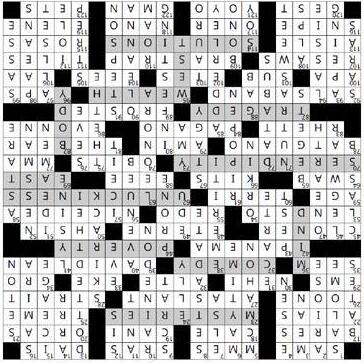The Boothby Review



Editor-in-Chief
G. Howard Hunter
Copy Editor
Erin Walker
Layout Design
Shay Steckler
Jack-Of-All-Trades
Sean Patterson
Production Assistant
Jennifer LaCorte Marsiglia

ANon-ConversationwithMaryBethEllis,Shay Steckler
JazzFunerals, L.A. Reno (see also pp. 40, 62, 88, 108, 116)
TheDouble, Sam Ferguson
AFilmLover'sDump,Mike Miley
TheHardProblem,Howard Hunter
RockabyeBaby!,Pam Skehan
LastDanceWithButtersandOmar,Justin Gricus
'They'reAlreadyHere':ADeeplyUnnecessaryDiscussionofInvasionofthe BodySnatchers(withspoilers),Robin Heindselman
Wild,Erin Walker
ThroughtheBellyoftheFish:TheFinalPlunge,Pam Skehan
DualityforDummies:ASubjectiveListofCrudeEvaluationsbyan UndereducatedPhilosopher,Sean Patterson
BookReview:TheMysteries,Howard Hunter
AuthorReview:AndersonCooper,Angela Beerman
BookReview:TheBomberMafia,Jason Hubert
FilmReview:Maestro,Howard Hunter
TheProustQuestionnaire:KatieAntis
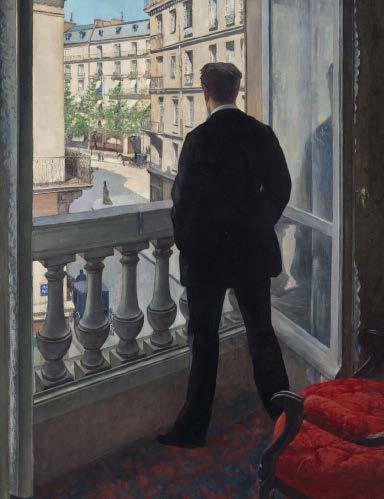
Seventeenth century philosopher René Descartes averred that we are the stuff of two substances— body and soul. The doctrine formally called dualism has its origins with Plato, who made distinctions between the unchanging realm of ideas and our physical world which is subject to the vicissitudes of life (for example my decaying human body as opposed to my soul). For obvious reasons early Christianity embraced Platonic thought, and we have a Western intellectual structure based on opposites, e.g., good/evil, male/female, or pleasure/pain.

In Volume 3 of TheBoothbyReview, we explore the problem of duality. In one work of fiction, there is a young man dogged by his doppelganger, and in another short story, a young woman sees herself in opposition to those other people who simply don’t measure up. Both works have an interesting denouement, to put it mildly. In one essay, we delve into the power of art in finding transcendence from grief. In other pieces, we celebrate a movie theatre unlike any other, as well as that nagging problem of humans vs. zombies. We also include book and film reviews that dwell on the vagaries of the human condition as well as photographs that mourn death and celebrate life through the jazz funeral. But of course, we could not let the notion of duality go unchallenged. Our first article is an interview with Madame Ellis from the Buddhist perspective. For many, the concept of duality is thoroughly contrived, a canard of Western thinking. We hope you enjoy.
 G. Howard Hunter, Editor-in-Chief
G. Howard Hunter, Editor-in-Chief

When I told Mary Beth the theme of this year’s TheBoothyReview would be duality, she seemed puzzled. Why? There’s no such thing as duality. Mary Beth Ellis has been studying Eastern thought for over fifty years. A practicing Buddhist herself, she has had the opportunity to study in Dharamsala, India, at the Naropa’s Buddhist University in Boulder, CO, to attend workshops and presentations by His Holiness the Dalai Lama, and to teach her own classes on Eastern thought and spirituality to both high school students and adults.
Shay: Ok, so talk to me about duality, or non-duality.
MaryBeth: Non-duality. It’s a very, very deep, complicated concept, and it’s not one that can be understood intellectually, although for purposes of this article, we need to make it an intellectual answer, so I’ll do my best.
Shay: So it’s not just that there is no duality?
MaryBeth: Well, here’s the thing. You can’t say that there is duality or that there is non-duality. You can only say maybe that there is NOT duality. Now, if that isn't confusing enough, that gives you an idea of the complexity of the situation. However, we are going to make it a little surface-y, facile, and easy to understand. You can’t understand it intellectually; you’ve got to understand it experientially, but the following might help clarify it a bit: Non-duality means that there is no subject and object. We are all one. Quantum physics has verified this in the last 50 years, this idea that’s been around for thousands of years in the East. What it means simply is that there is no separate object or person that exists in and of itself. Every object, even a physical object, is just energy, energy that exists in everything else. We all know now that a human being doesn’t have any of the same cells he or she had seven years ago, so it’s easy to imagine that all the energy is constantly coming and going in and out of people. It’s one of those things like: “Is the wave part of the ocean or a separate entity?” That would be an example of duality or non-duality. Some people would say quite accurately that the wave is the ocean. That’s non-duality. But then other people would say, “No, there’s a separate wave.” That’s duality. But, those are intellectual concepts like, “How many angels can dance on the top of a pin?” The point is that everything is a mental concept if you’re gonna talk about this, which you really can’t.
Shay,laughing: So we’re not having this conversation.
MaryBeth: We are not having this conversation. (Shegiggles.) It makes sense for everything. For example, a cloud, you can’t say a cloud is a separate thing, a cloud is made up of air molecules and water molecules, etc., and everything is like that— everything is part of everything else. So that’s kind of an easy way to conceive of the idea.
Shay: In Eastern thought, there’s no good and evil; it just is?
MaryBeth: Yes. Everything just is. Good and evil is a concept in the human mind. Some people thought Hurricane Katrina was evil. Now, many people think it changed New Orleans for the better. Most things we get negative about and consider bad are just triggering some unresolved seed in us. Spiritual teachers often say that what we consider bad or evil events in our lives lead us to God. Thomas Keating terms these things “the 1,000 paths to God.”
Shay: What about Plato’s cave allegory?
MaryBeth: Well, Plato is someone who understood that idea because he understood that our concept of what reality is is not at all what reality really is. We see only the shadows on the cave wall; we have no idea what’s out there creating these projections. And that’s the way everything is in our mind. I mean that’s a perfect example of the way that our minds create their own reality. We are seeing nothing but shadows in the cave. All day long. That’s it. And it takes probably years and decades of meditation, honest self-reflection, and dealing with this idea to truly start experiencing what it is—not just intellectualizing about it. You couldn’t explain to somebody sitting there in the cave who had looked at nothing but those shadows for a lifetime that they aren’t reality. It’s not until they break their chains, turn around, and go out and experience reality that they can see the Truth. “Oh, that’s what it is. It’s the shadow of this.” But what we are doing right now is talking about two people sitting in there looking at the shadows who have never seen anything but the shadows, who are chained, talking about the possibility that maybe it’s not reality. But they have no concept of what it might be. That’s what I was referring to. How do you tell someone what chocolate tastes like if they’ve never eaten any? Carl Jung and the latest in neurolinguistics talk a lot about unitive consciousness or non-duality, so it’s now becoming very popular, but it’s a concept that has been around for many thousands of years in the East, and which has even been in Christian teachings since the 4th century of the Common Era. The oneness of all life is not new at all.
It’s a given in Hindu and Buddhist teachings, like the Upanishads and Vedanta, so it isn’t often discussed. It’s only been recently in the West that it’s become trendy. Buddha didn’t talk about it at all.
Shay: Because non-duality doesn’t exist?
MaryBeth: It’s more that Buddha was very pragmatic. He was not into intellectual concepts, but since Buddhism morphed out of Hinduism, the concept was there; however, in the East it is such a given that they wouldn’t need to discuss it.
Shay: Buddha wouldn’t have mentioned duality because there was no duality to even mention.
How do you tell someone what chocolate tastes like if they’ve never eaten any?
MaryBeth: Right. He wouldn’t have thought of it. I don’t know, nobody does, because nobody knows exactly everything Buddha talked about, but from all the writings and the research, most Buddhist scholars say, “No. Non-duality was a concept that started later because in the West, we tend to think in dualistic terms.”
Shay: So the idea of non-duality came out of the West?
MaryBeth: No, it came from the East, but the West has made a big deal about it because we think in dualistic terms. Like so many intellectual concepts, Buddha never taught it. He left Hinduism because he didn’t like all that intellectualism, dogma, and ritual. He was pragmatic: Be good. Be compassionate. Help everyone. Life is what we make it. People just made it very complicated, and duality was one of those concepts. But, we can understand that in terms of quantum physics—life is all energy, and it’s all inter-related. Thus, all life is one.
Shay: Right. Like light and dark. Dark is simply the absence of light. It’s not a separate thing.

MaryBeth: Yes. It’s like the yin and the yang in Taoism. You’ve got the black and the white, but each one has within it the opposite. And it can’t be what it is without that. And that’s only a small symbol of it right there, but the point is that we have in our minds the concept that there are fixed material objects out there and they each mean a certain thing. We in the West are totally victims of this dualist thinking, like the people watching the shadows in Plato’s Cave Allegory. That’s why we have this concept of nonduality; we need it to break free from our concept of duality, which in the East is a given.
Shay: That’s why you gotta meditate.
MaryBeth: I didn’t say it, but that is said to be the truth. Years of meditation allows us to make the necessary shift in the hardwiring of our programmed dualistic perceptions. Then we actually can go out into the world and see the reality of what projected the shadows in the cave, which we thought was reality. Otherwise, we are stuck in the cave looking at the shadows and perhaps intellectually talking about the fact that it’s not real, but we have never really experienced liberation.
Shay: Because we haven’t experienced being one with the all.
MaryBeth: Yes, it’s only a concept in your mind, and intellectual concepts don’t work with basic reality. Bottom line, non-dualism is a very trendy, recent concept in the West. No one talked about it in ancient, authentic Buddhist texts. The concept was a given. Christianity’s dualistic concepts brought about the word’s use. To a Hindu or Buddhist, it would be like saying, “I have this revolutionary idea: the sky is blue.” Duh.
The whole thing is akin to the last scene in The Wizard of Oz when Dorothy realizes that the shoes which can carry her home have been right there on her feet the whole time–or maybe like Moliere’s Bourgeois Gentilhomme, who is so proud of himself because he’s been writing in prose his whole life and just didn’t know it. We can’t really talk about non-duality, because duality doesn’t and never has existed. Or as Thomas Merton said, “You have to experience duality a long time before you realize it’s not there.”
Shay: I love that.
MaryBeth: Isn’t that fabulous?
Shay: Well, it was really great to not have this conversation with you.
MaryBeth,laughing: Even though it’s a conversation about something that you can’t discuss anyway, it’s been very interesting to do so.
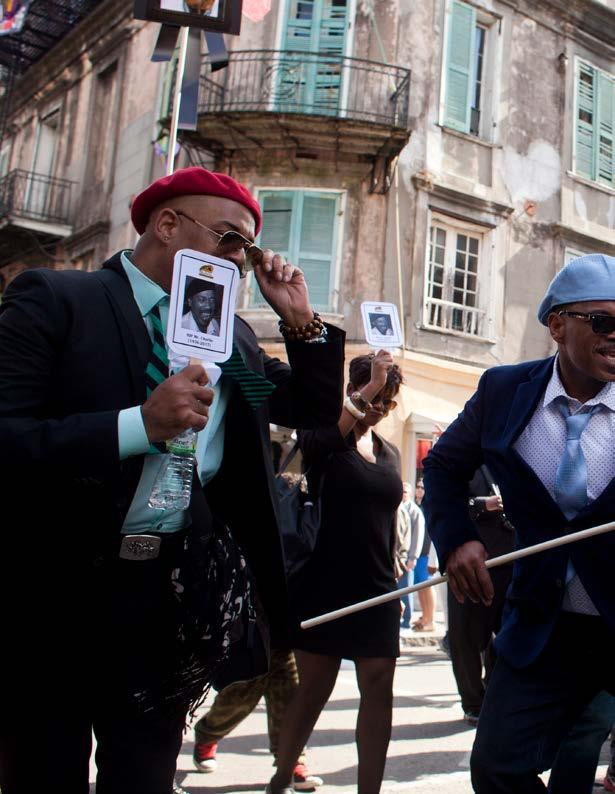
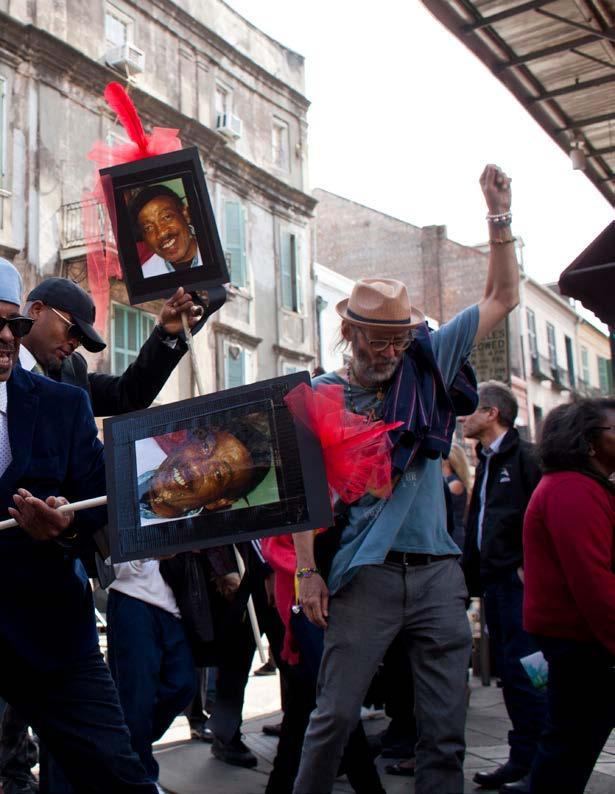
It was there, on the Wilhelm Tower’s only functioning elevator, that Schmidt was first apprised of the existence of his double. Mr. Beckroth—the president of Kaiser Bank and thus, though far removed, Schmidt’s ultimate superior—was waiting at the threshold of the lift, just off the lobby, his suitcase in his left hand and his bowler in his right. He had not, it seemed, seen Schmidt, who had halted just behind him and a few steps to his left, nervous lest this man, with whom he’d exchanged only meaningless pleasantries, should recognize Schmidt and condescend to conversation. It was rare, Schmidt thought, for Beckroth to be here—now, at seven thirty, thronged by common clerks and even janitors and chambermaids. His hair was combed back in luxuriant waves, and his dark pinstripe suit and Italian shoes—shined to a bright and exorbitant black—emphasized the tanned, athletic vigor of his skin. He was, Schmidt guessed, about sixty years old, though he remained, despite his age, a man of intimidating briskness and vitality, like a general who still lusted after combat.
The doors drew apart, and Mr. Beckroth stepped inside. Schmidt scurried after, his face turned away, hidden by his shoulder and the bustle of the others—three men and two women—who were filling the compartment. But Schmidt, for all his stooping, was a very tall man, a tousle-headed scarecrow in a just-too-tight suit, and Mr. Beckroth, standing with his back against the rear wall of the lift, his gaze frankly trained on the oncoming scrum, soon spotted and addressed him.
“Eckermann, my boy.” He reached across the lift and squeezed Schmidt’s arm. “I heard all about the new Teitelbaum account. A fine piece of work. Yes, you’re well on your way.”
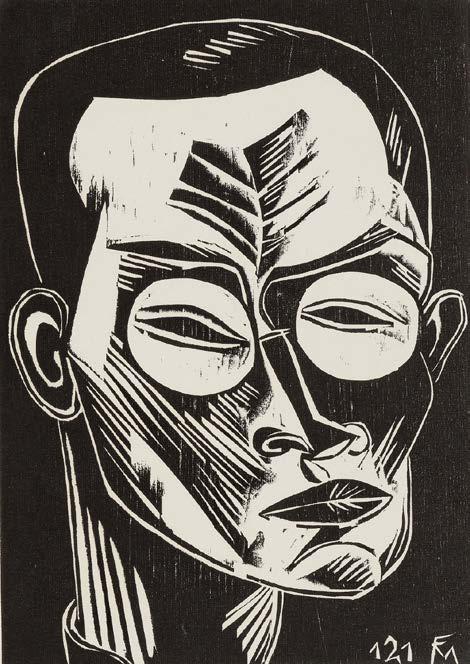
It should have gone without saying that Schmidt wasn’t Eckermann. He was Schmidt. But how, without considerable embarrassment, could this fact be made known?
“Teitelbaum, sir?” asked Schmidt, with no intention of sustaining his superior’s confusion.
“Oh, such modesty is charming to your peers, I have no doubt. But you shouldn’t try it out on an old rascal like myself. I’ve been watching you, Eckermann. You’re a killer. Just like me. And that’s exactly what we need. A whole floor full of killers. A whole army of Eckermanns.”
He was smiling up at Schmidt, still pinning his arm in his firm, virile grip.
“Thank you, sir,” said Schmidt. “But I—”
“Oh, thank you’s enough,” interrupted Mr. Beckroth. “There’s no need to play down your successes with me. Your thanks is enough—and, of course, your continued success.”
“Yes, sir,” said Schmidt, “but I should tell you—”
“Know when to say when, Mr. Eckermann. Please. Now this is my floor. You’ll see more of me soon, I’m quite sure of it. Excuse me.”
He gave Schmidt’s arm a valedictory squeeze before stepping through the pack of lesser laborers and exiting, at last, into the lobby of his office—that marblefloored, wainscoted palace of an office which occupied the whole of the tower’s tenth floor.
Schmidt’s confusion was compounded by the kindness of this praise, and any pleasure thus intended was converted into pain—the lingering sting of embarrassment, the shattering blow of his own anonymity. The president didn’t know Schmidt from this Eckermann—did not, evidently, know Schmidt in the least. The praise, what was more, had simply emphasized his weakness, the inertia and stagnation that had qualified his clerkship. He felt himself reproved within the shadow of a genius.
The seventeenth floor, where Schmidt stepped off now, was wholly given over to the junior clerks’ work room, a vast but stuffy space in which the cluttered dispensation of the workers and their desks had formed a densely crowded grid, a hive of buzzing industry with minimal partitions and a sense, overall, of assiduous drudgery. The room ran the length of a regulation football pitch, and there were countless men and women here whose faces Schmidt knew well and yet whose names, in their abundance, he had never thought to learn. Here, in the work room, a man rarely spoke beyond the barest verbal needs for the conducting of his business. It was a hub of oblivious, name-bereft faces, a world in which the passing of the hours was marked by paperwork, by the signing of contracts, the stamping of missives, the approval or denial of debentures and investments.
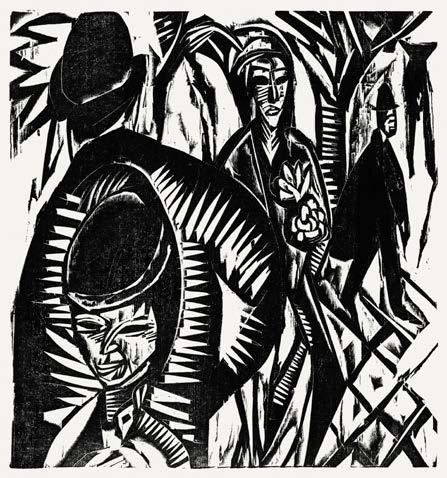
He proceeded to his station at the center of the room and was halfway down his aisle when he noticed, at its end, a man he didn’t recognize. The man was tall, as tall as Schmidt, and he had the same halo of tousled brown hair, which rose from his scalp in great bristles and curls. But where Schmidt was rail-thin, and where he shuffled with a skittishness made quick by his anxiety, this stranger was sure-footed, muscular, bold. Eckermann, thought Schmidt. His double. This was Eckermann.
He sat down at his desk and tried to focus on his work. But even here, from his chair, he saw Eckermann, who had sat on the edge of Ms. Bierbrauer’s desk. He was leaning flirtatiously towards her, his curls hanging low on his broad, handsome brow, while Miss Bierbrauer—the work room’s chief secretary, a severely pretty woman who was never known to smile—actually threw back her head with a laugh, her pale and lovely throat profoundly naked in her mirth. It was, Schmidt thought, an unbelievable sight. Unbelievable, yes, but also distracting.
He turned to Leo Reuss, his only friend at Kaiser Bank. Reuss’s nose was to his desk, farsightedly pressed toward a sheaf of fresh contracts.
“Reuss,” said Schmidt. “Hey, Reuss. Who’s that man?”
“What man?” asked Reuss.
“That man. Over there.”
Reuss lifted his head. His eyes followed Schmidt’s to the end of the aisle.
“That’s Eckermann,” said Reuss. “A man on the rise.”
He’d spoken with an edge of nasty irony. He was short and frail himself, and all signs of male strength he perceived as a slight to his own quite diminutive person.
“How do you mean?”
“The Teitelbaum account. You heard about it, didn’t you? A tricky bit of business, though he sewed it up perfectly. Say what you will about the way he walks around the place, like Jehovah’s own gift to the world’s junior secretaries, but the man gets results. He’s efficient. He’s ruthless. They say he’s due for a promotion.”
“A promotion,” Schmidt quavered with impotent envy. “How long has he been here? I never saw him till today.”
“As long as you’ve been here. For five years at least.”
“Have I been here that long?”
Reuss shrugged, unenticed by the mysteries of time, and readdressed himself with interest to the contracts on his desk.
Schmidt, for his part, struggled to ignore the rampant laughter of Miss Bierbrauer—the only sign, without his looking, that this Eckermann was there. But soon he had immersed himself in drafting memoranda, and when, some time later, he looked up from his desk, he found that his double was gone, that he had disappeared at last within the vast hive of the work room.
The rest of the day involved no further incidents—until, that is, Schmidt’s departure, which was colored by the knowledge of his double, of his bearing a resemblance, however pallid or unfavorable, to the vigorous and enterprising Eckermann. It was normal for Schmidt to leave promptly at five, rushing toward the exit, meeting no one, saying nothing. Today, however, was different. Today he crossed the work room with a light, audacious jauntiness and turned his eyes unflinchingly on everyone he passed. He was looking for the gestures of mistaken recognition, for a smile or a nod or a greeting for Eckermann, and these he was to find in each new person that he passed, who seemed to regard his great towering awkwardness not as a threat or as some lanky imposition but as the natural gait and stature of a colleague on the rise. Several women smiled. Several men said good evening. And when he made it to the lift and saw the doors were closing quickly, he was gratified to find a colleague’s hand shoot forth to hold them. His gratitude, quite naturally, was met with further warmth—a gentle, smiling nod, the happy music of You’re welcome.
The small world of the work room and the tower seemed to blossom, to open up before him with a bold but yielding easiness. It struck him as unseemly, his usurping of this ease. He felt, as he descended, like a con-man or a thief. usurping of this ease. The president himself had called him Eckermann. Schmidt had not succeeded in correcting him—had crumbled. Was this not, on its face, an unsustainable imposture?
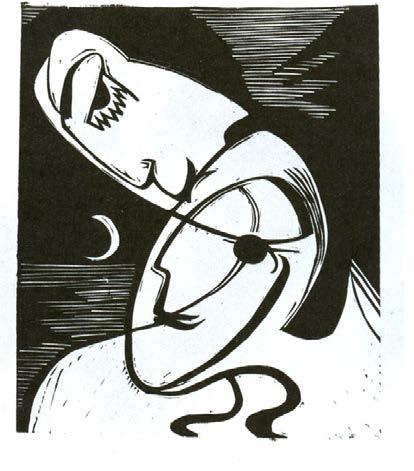
As always he stopped at the Black Marten Inn, one block from the apartment where his wife and son awaited him. He liked, on a Thursday, to nurse a frothy pint and read his favorite evening paper, alone with his thoughts and the news of the day before the caterwauling nagging of his family obligations.
He’d sat at the bar and had waved for his drink when he noticed, in the corner, the unexpected silhouette of Eckermann. Had he followed Schmidt here, from the office? Was this some sick joke, some theatrical prank, performed by unseen agents bent on Schmidt’s humiliation? But such a joke, when he considered it, did not at all seem likely. Eckermann had clearly finished several rounds already, and his gaze, far from crafty, shone with all the florid joy of heedless dissipation. He was joined, what was more, by a woman—a woman ennobled by a beauty so uncommon that it emphasized the commonness of everyone around her. Everyone, that is, except
Eckermann. He shone further still in the flame of her presence. They were beautiful together—beautiful and drunk and frankly amorous. Eckermann had draped a winsome arm around her waist, and she, like Miss Bierbrauer, tossed back her head at this charming man’s quips, which Schmidt couldn’t hear but which came, as she laughed, with a frequency and skill that might stir envy in a clown. Was this, Schmidt thought, some kind of fancywoman? But no, she surely wasn’t. Such women didn’t laugh with such conviction—did not seem so enamored of the men who were their “patrons.” And this wasn’t, besides, the place for fancy women. The neighborhood was quiet. It was decent. It was home.
Schmidt’s glass, he now found, had been emptied. He waved once again at the barman.
“Another, Alphonse. Just one more.”
“Anything else, sir?”
“Yes, in fact.” Schmidt was whispering. “Who is that man?”
“Who, him?” Alphonse crowed. “That’s Eckermann, sir. You know him. He’s a regular.”
“I’ve never seen him in my life. He’s a stranger to me. Or he was, till today.”
The bartender paused, as if considering the likelihood of Schmidt’s not knowing Eckermann.
“He’s a gentleman,” he said, imbuing the word with inscrutable humor. “A gentleman who’s never to be found without a lady. The things I’ve seen from him, it’s a wonder he’s not famous for his exploits.”
“Exploits?” asked Schmidt.
“I shouldn’t talk. It’s not correct.”
“He’s a lothario, you mean.”
“I’ll say no more. You can see, sir, for yourself.”
And with that he stepped back, taking Schmidt’s glass and refilling it, expertly. Schmidt in the meantime glanced back toward this Eckermann. Should he introduce himself? Acknowledge the fact of their mutual workplace? Eckermann’s lady—for all her self-possessing laughter, she seemed somehow his—stood now from the bar and retired, Schmidt presumed, to the powder room. For the first time that day, Schmidt could study his man from up close, sans distraction. He decided not to speak to him, to investigate instead what bonded Eckermann to him, and what, for good or ill, distinguished each man as his own sovereign self.
The comparison, in one sense, flattered Schmidt. His double was lean-jawed and wolfishly handsome, with an intensity of aspect—a burning of the eyes, a thoughtful crinkle of the brow—that was wholly prepossessing. Though wasn’t there something grotesque in his handsomeness, a leering, preening ugliness that underlay his charm? It was, he half-realized, his own timid resentments, reflected and refracted in the beauty of another. He felt a flash of violent hatred, a comet-streak of rancor in his stomach and his chest. He wanted, inexplicably, to beat him—to annihilate this double as a rival, as his foe.
The woman was returning. She crossed the gloomy barroom, illuminating all with her unyielding femininity. Eckermann turned, looked at Schmidt, shot a wink. Schmidt spun away, as if caught in some crime.
He glanced at his pint. It was empty again.
He set down his money and pulled back his chair and then left at a furnacecheeked, self-loathing trot. Night, to his astonishment, had already fallen. How long had he sat there, glowering at Eckermann? His wife would be waiting; she would doubtless be worried, and likely irate. His supper, what was worse, would now be cold.
He stumbled ahead, slowed by incipient drunkenness, and made it at last to his building. He climbed the grim stairs to his third-floor apartment, where Rudolph and Mathilda were awaiting him. The child, by now, would be sleeping. Mathilda would be sitting in the kitchen in her wrapper, her arms and legs folded, her face set in righteous, corrosive disdain.
It was as Schmidt had suspected. The apartment was dark, except for the
kitchen, where Mathilda sat stooped at the table—refusing, evidently, to ask him where he’d been.
“I’m sorry,” he said. “Didn’t mean to be late.”
“Quiet,” she said. “Do you want to wake Rudolph? He’s finally asleep.”
“Sorry,” Schmidt repeated. He stepped into the kitchen, bumping, with his hip, the room’s only lamp. He caught it in time, but not before spitting a sharp, too-loud curse.
“Please,” she said. “Please. Just sit down and be quiet. Come sit down and eat.”
He stopped where he stood and considered his wife. Hers was a conditional beauty—a fineness that was squandered in these circumstances, the burdens of the housewife having snuffed the inner candle of her loveliness, which nonetheless burned, Schmidt reflected, when perceived from certain angles, or on those rare but sweet occasions when she drifted into happiness—when she laughed with the baby or, exalted by the turnings of her own capricious heart, broke into a folk-song from her childhood, a melody derived from the Arcadia of youth.
“Please,” she said. “Sit.”
No music, he knew, would now float from these lips.
“One moment,” he said. “I want to see Rudolph. To check on him first.”
He left her in the kitchen, where her silence spread and rose into the low hum of contempt.
The child was in his crib. Schmidt, though he regretted it, had a theory which explained his own detachment from his son, from the supine, snoring form of this defenseless, sinless child. The boy, little Rudolph, spent his days dandled and cosseted, engaging in wordless and burbling colloquies with the woman who, till recently, had dedicated everything to Schmidt, to the washing and the cooking and the labors of the marriage bed. But such a complaint, he understood, was superficial—was savagely self-centered and opposed to his own character. His true
complaint, the source of his discomfort and distrust, had to do with her motherly influence. Schmidt—as the father and main earner, the champion of his family in the huge devouring world—had forfeited, by necessity, the experience of witnessing his infant son’s formation. This was as it should be, by the standards of his day. And yet he found himself distrusting his own wife, resenting the allegiance between Rudolph and herself. There was, for example, the way she sometimes clutched him to her chest, turning him from Schmidt—giving her husband, quite literally, the cold bone of her shoulder as a bitter consolation. The child, Schmidt thought, had even begun to resemble her, to lose whatever traces of his own face he had seen there, in the blank slate of his son’s—had imagined, it now seemed, in the first quixotic blush of his paternity.
Rudolph sighed and gurgled, turning his head toward the wall of his crib. Schmidt considered reaching out to touch him, rub his chest, but then he reconsidered, afraid that he might wake him and inspire a fit of tears. The child sighed again.
Schmidt turned and stalked out, toward the kitchen and his wife.
A week passed uneventfully—uneventfully, perhaps, and yet laced with the venomous taint of suspicion. The smiles which Schmidt received within the work room and the lobby—even, on occasion, on the street—did little to convince him that he hadn’t been mistaken, that he wasn’t, in effect, being erased by these innocent grins. Each smile was like a slap, a reminder of that smooth, flirtatious operator, Eckermann. He never smiled back, averting his gaze and then hurrying on, as if by quickening his pace he might discourage all such errors and assert himself anew. He was Schmidt, his walk said. He was Schmidt. No one else.
He’d seen his double only rarely, from a distance in the work room: dazzling Miss Bierbrauer, slapping backs with nameless colleagues, passing with his graceful gait from one desk to another. Schmidt, when he saw him, did not watch for long. It was sickening enough to know that Eckermann was present, preening and ascending and impressing all he met.
On the following Thursday, Schmidt sat immersed in his work, at his desk, when Leo
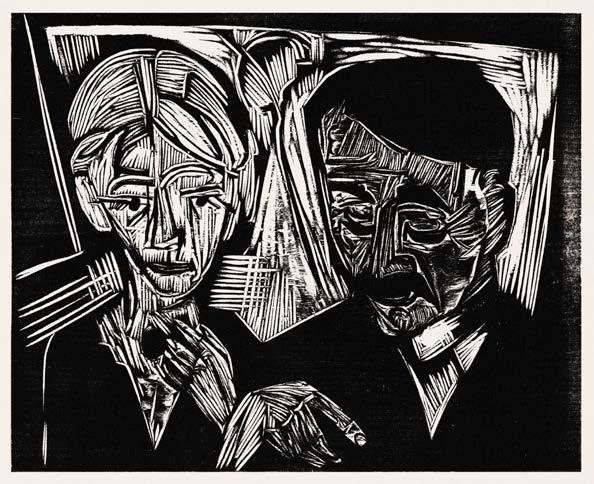
Reuss turned to him, hissed for attention, and coughed up a morsel of scandalous gossip:
“You hear about Eckermann? About the Havermeier deal?”
“I haven’t heard a thing.”
“Word is he forged a few signatures. A councilman’s or senator’s or something. They’re saying Beckroth knows. Not only knows, but does not disapprove. The bastard is bulletproof.”
“That can’t be true,” said Schmidt. “That’s simply not true.”
Reuss’s grin was disconcerting: a jack o'lantern leer that suggested—in its jaggedness, the angles and cracks of its ludicrous wiles—some obscure point of satire. Was he playing a joke on his friend? Was Schmidt being lied to for reasons unknown?
“I assure you, dear Schmidt, that it is.”
Schmidt stood without a word and hurried off toward the toilets, where at least he could be free from Reuss’s grin.
At the far end of the aisle, a pretty young woman whose name he didn’t know looked up at him and smiled with eager openness.
“Mr. Eckermann,” she said.
He shuddered, rushing onward, refusing to acknowledge her or any other person.
Now, in the lavatory, assessing himself in its large, shining mirror, he was reassured to find he hadn’t changed—that these were his shoulders, and this was his hair, and this the same gaunt, inarticulate visage. He decided to leave early, to fortify himself with several drinks and then go home. He was feeling very faint, and it was three o’clock already. Any hope of productivity, he told himself, had gone.
He returned to his desk, collected his things, and left in a harried, undignified silence.
He was down in the street when he heard, once again, the other man’s name used against him.
“Eckermann, my boy!” the voice boomed. “Eckermann, you rascal, won’t you stop and chat a minute with your withered old employer?”
Schmidt turned but didn’t stop. It was Beckroth, the president, his hair raked back in great masculine waves, his step sure and brisk as he charged after Schmidt like some fearsome but gregarious policeman. He was anything but withered. He
was, instead, terrifying—the very form and figure of a huge, robust confusion, an error of the universe which hounded Schmidt and hinted at his secret obsolescence. The president loomed—he was ten feet away—and Schmidt turned and ran down an alley, a fugitive.
He sprinted through the streets, sightless to the glares of all he passed, and blundered at last through the doors of the inn, proceeding with a clatter to the barroom and his stool.
Alphonse was at the bar, slicing citrus wedges with a bright and curving blade.
“Afternoon, sir.”
“A shot,” Schmidt gasped. “A shot and a pint.”
“Right away, sir,” said the barman, turning with a private, knowing smile.
It was then that Schmidt swiveled and scanned the whole room. What he saw there should not have alarmed him, yet did. Eckermann was seated at the far end of the bar, flanked not by one, but by two laughing women. These ladies, two strangers, were dressed in a manner more flagrant, more revealing, than anything one found outside the slummiest of brothels. Skirts hiked high. Necklines plunged. Stilettos shot up at precipitous angles, tipping both girls toward the bar, their chests outward. Eckermann bellowed some hideous joke, the words of which were lost upon the seething, frantic Schmidt, and the women, as expected, tossed back their heads in a bright and gleeful preview of erotic satisfaction. Eckermann, they cackled, was a card.
Alphonse placed the shot and the pint on the bar, and Schmidt gulped them down without pausing to breathe. He drank as if the liquor might alleviate the horror, the rotten, toxic horror that was eating up his lungs.
“Another,” Schmidt said. “Bring another, Alphonse.”
He’d shouted this order, his voice a shrill yelp. But Alphonse had stepped out, and the barroom, but for Eckermann, was empty.
“And what is it, friend,” asked a low, steady voice, “that’s got you so upset?”
Schmidt turned. It was Eckermann—smiling at him, winking from between his laughing girls.
Schmidt couldn’t speak. He sat there and stammered, his face growing hot.
“Why don’t you join us?” asked Eckermann. “There’s plenty to go around.”
There was something in his voice—something in the dreadful exclusivity of plenty, the way this man was boasting of the harlots on his arm—that pushed Schmidt into action.
He seized the bar’s knife and charged blindly at Eckermann. The women shot upward and ran away screaming, clambering and scratching at each other as they fled. Eckermann, however, didn’t flee. He lifted his arms, spreading them as if to greet his double, to embrace him. Schmidt tumbled forth, stabbing wildly at his stomach, striking at his chest and outstretched arms. He hacked and ripped and tore and slashed until the mass of stubborn flesh and rigid bone that stood before him had yielded to a slouching sac of sanguinary chunks. His double had slumped to the floor. He was dead.
Schmidt stepped away and looked down at his hands, at the bloodstains on his shirtfront and his pants. No one could have seen him but the women, who had fled.
He threw down the knife and ran out, to the street.
It was, or should have been, the busiest hour of the day. But the streets were somehow empty, and as he scrambled down the pavements in his soiled and sopping clothes, he was fortunate, it seemed, to pass unseen by any witnesses. Outside his own building, he stripped to his undershirt, stashing his jacket and tie in an ashcan. His pants were still stained, though these he could dispense with on his threshold— stow them in a corner and produce some desperate alibi. A can of paint had fallen from a ladder as he passed. A drunken man had vomited upon him in the street. A meatball had slipped from his fork in the lunchroom, sullying his shirtfront and the fabric at his crotch. She should not, he’d insist, waste her time with the washing. The problem was his; he’d address it himself.
He crept into the living room, reduced now to his underclothes, padding in his
garters and his socks. Mathilda sat as always at the table in the kitchen, absorbed in a book, its title obscured by her soft pinkish hands. She had not, evidently, heard him enter. He observed her quiet face, illuminated now by the enchantments of her leisure, and flinched, for the first time since fleeing, with guilt. He felt nothing for Eckermann—only for himself, and for this woman he’d destroyed through the fulfillment of his rage. She was beautiful, he realized, and never again would he come home to find her, reading and at ease, with their child in its crib and a pot on the stove, bubbling appealingly with spices, fragrant steam. He took a step toward her. She sighed and looked up.
“Your clothes,” she said. “What happened?”
“An accident,” he told her, “with a workman and some paint. I had to throw it all away.”
She set down her book. The sense of his lying was palpable, dense, though she seemed—it was a miracle—incurious, at ease.
“Where’s Rudolph?” he asked.
“He must have stepped out,” said Mathilda. She smiled.
“Right.” Schmidt laughed. “But of course. He stepped out.”
He approached his wife and kissed her on the softness of her cheek, a whim so strange and surprisingly affectionate that she yielded to it instantly, her face offered up like a fresh, buoyant rose.
“I’ll go check on him then.”
The child lay asleep in the nursery. Schmidt saw his face and was filled, once again, with a horrible remorse—the shivering antithesis of all that had impelled him toward his savagery, his crime. The child sighed and burbled, rolling toward Schmidt in some vague whim of sleep. What did Schmidt see in the long, pallid brow; the thin, curving nose; the resplendent blonde hair? Was it, he wondered, himself? Or was it—it occurred to him, descending like a sickness—some phantom trace of Eckermann, surviving in his son?
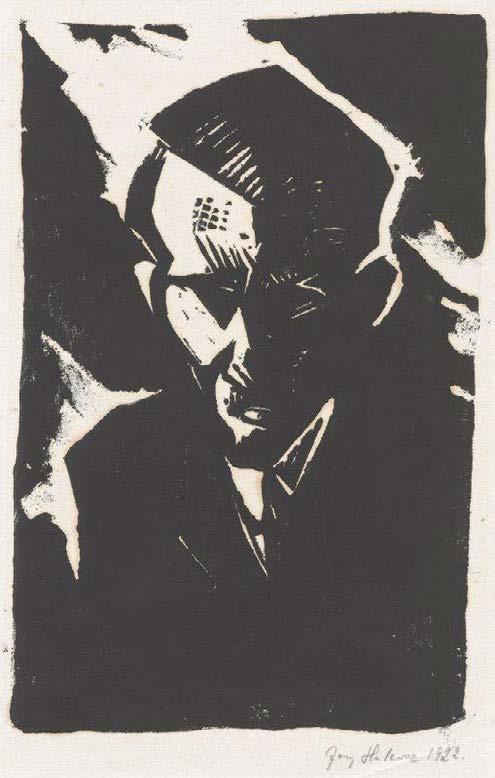
He stepped away in horror, toward the kitchen and his wife.
He expected, in the morning, to be arrested with his breakfast. But when no one came knocking, and when no one apprehended him or seized him on the street, he began to assume some mistake had been made. In the blackest hours of night, he’d accepted what he now viewed as his destiny: his arrest; an accelerated trial; his execution, swift and final, by the even-handed state.
He took the lift as usual, though no one in the lobby or the elevator looked at him. No one smiled or nodded or mistook him for another. The lift rose and stopped, depositing Schmidt in the bustling work room. He stalked to his desk— unnoticed, unhailed.
For the first time in years, Reuss was not at his desk, which was tidier than ever—its papers piled and gathered, made anonymously neat. Schmidt sat and waited, unable to attend to any problems but his own. Soon, he understood, he’d feel a rough hand on his shoulder. He’d hear his name barked with retributive wrath. He’d yield up his wrists to their shackles, then stand, then go where they led him, his face dark with shame.
Several hours passed. Several days. Several weeks.
But no one ever came. And no one—not a soul—could restore him to himself.


When it comes to movie theaters, I can be a bit of a snob. I expect, perhaps even demand, that theaters project films in their proper aspect ratio from the highest quality source material with all audio levels and image values properly calibrated. If a lazy projectionist leaves the 3D filter on a 2D movie, I’ll know, and I’ll say something. (I am an absolute joy to be with.) As my recent trips to New Orleans cinemas have shown, no one else will care, especially the teenage employee tasked with listening to my complaint.
Given my admitted snobbery, you might expect a multiplex like the ArcLight in Los Angeles or a movie palace like the Egyptian to top my list of favorite movie theaters. These places revere the movies as an art form and place them ahead of anything else attendant to the theatrical experience, even previews, even rumbling subwoofers, even high fructose corn syrup. While those two certainly rank highly on my very short list, my favorite movie theater of all time is far less lofty. In fact, it’s about as far from a Snob’s Paradise as one could get. The Egyptian and the Cinerama Dome may be great places to see the greatest films, but they cannot match the carefree attitude and dubious glory of New Orleans’ Movie Pitchers.
Movie Pitchers was a four screen, second-run theater at 3901 Bienville St. that specialized in independent and art-house films. The first films that screened there in May 1991 give you a perfect sense of the range they would have on offer during their ten years of business: the B-horror flick Warlock and the Oscar-winning Italian nostalgia piece Cinema Paradiso. Duality dominated their marquee. A Cuban film such as Guantanamera would play next door to the latest Troma film, a quirky doc such as HandsonaHardbody would screen after the latest by Woody Allen or Almodovar. This sense of adventure extended beyond film programming to include regular midnight screenings of RockyHorrorPictureShow (complete with a shadow cast) and weekly performances by the improv comedy troupe Brown!, where cast member Dr. Ken Jeong entertained audiences before moving on to TheHangover and TheMaskedSinger. Such eclecticism may be old hat in the era of 20-screen multiplexes, but in the 1990s, this clash constituted an almost radical remapping of cinematic taste that obliterated the divide between high and low and replaced it with a more egalitarian and curious sensibility.
Today, movie theaters are just another one of dozens of goods and services that have experienced a bougiefication in which business owners seek to inflate the experience (and prices) of their product with higher-end versions of basic amenities. Over the last twenty years, we have seen concessions at movie theaters go from the
basic popcorn and soda to truffle parmesan kettle corn and bespoke cocktails, and seating transform from a glorified folding chair to fully reclining faux-leather seats with cupholders, trays, and a button to page the waitstaff. These developments seem like necessities as theaters compete with increasingly sophisticated home theater equipment, prestige television, and a deluge of streaming content, but all arguably distract from the films in one way or another. The prosciutto flatbread and boneless wings turn the auditorium into a restaurant, and the well-heeled artisanal baubles reduce this populist art form into an elite space to see and be seen, diverting eyes from the art on the screen toward the self-regarding gaze of the attendees.
The sad, overlooked fact is that Movie Pitchers was already doing most of these things touted as elite experiences in its own no-frills way. Unlike those other, fancier places, people came to Movie Pitchers for high-quality movies at video-rental prices.
Along with its programming choices, its humble appearance obscured just how much Movie Pitchers was ahead of its time. It sat in a nondescript building that kind of looked like a video store or insurance office from the outside and wasn’t much bigger on the inside. What it lacked in grandeur it made up for in grungy charm, economy, and, in true New Orleans fashion, booze.

Movie Pitchers had draft beer and a full-bar before it was cool, and they weren’t as concerned with technicalities such as legal drinking ages or photo identification as their current-day analogues. They also served some surprisingly tasty sandwiches that they would deliver during the movie on a paper plate. Granted, “delivery” meant an employee walking into the middle of the movie, blocking the projector, and shouting “Who had the ham and cheese?” Distracting perhaps, but it didn’t seem to matter all that much. After all, what was there to complain about when you were drinking a draft beer in a movie theater?
The screening rooms were the antithesis of impressive. In fact, they would horrify most people, as in they’d probably get themselves tested after just peeking inside. But that’s all part of the charm. The screen was half a baby step up from a bedsheet, the sound was just good enough to be audible, and the ceilings and projector were positioned so low that if anyone sat up straight their head would block the screen. But you didn’t need to sit up because each screening room at Movie Pitchers was furnished with nothing but couches and lounge chairs. Not the plush rocker kind, mind you: these were … what’s the phrase … lived in —mismatched, moldy-ass couches that every freak in Mid-City had done God knows what on over the years. (This probably explains why they never turned the house lights on, no matter what.)
Afterall,what complainabout weredrinking a movie
As for the screenings themselves, well, you never knew what was going to happen, even if you’d seen the movie before. At most theaters, Paul Thomas Anderson’s BoogieNights runs two hours and thirty-five minutes, plus previews. But at Movie Pitchers, it lasted nearly four hours one time because the film broke several times, each time requiring at least fifteen minutes to repair. Had this happened at any other theater, I would have been incensed, but here, it was barely even an inconvenience. It was what you paid for, part of a (literal) night at the movies. (Part of me suspects they broke the film on purpose to sell more alcohol.) I have two strips of film prints that broke at Movie Pitchers, and they are among my most prized possessions.
Yes, Movie Pitchers was a complete dump, but it was a film lover’s dump. For $5 a ticket, you could see all the foreign and arty indie films that didn’t play anywhere else in town other than the overpriced Canal Place in the French Quarter. In fact, the old Canal Place theater was Movie Pitcher’s mirror image, the twin separated at birth who gets to live in the rich neighborhood and attend the nicer schools. Both were four-screen theaters that showed art-house and independent films, although one sat atop a fancy shopping mall (Canal Place) and would get the films first, and some of the prints would eventually trickle down to the rundown building in Mid-City (Movie Pitchers). But for all its shiny, well-heeled surfaces, Canal Place did not have the warmth and charm of Movie Pitchers. They didn’t have the sofas that fit like a thrift-store glove. And they certainly didn’t have the drinks.
theater?
Some of these choices were deliberate, others were the result of necessity, happenstance, or obliviousness, but all of them added up to something that is virtually extinct in America: a blue-collar art-house theater. Every development in the theatrical experience has endeavored to keep these two concepts separate, to impose a strict duality in which high-class art and the general populace do not mix. What Movie Pitchers understood, perhaps on an intuitive level, was that movies are a popular art form and that people who may only have $5 to spend on a movie ticket would be interested in quality cinema and the community that attends it. To look at the theater and complain that it wasn’t fancy enough was to miss the point entirely.
Something this wonderful could only exist in New Orleans for so long. In the fall of 2000, the supermarket chain Sav-A-Center began construction on a new location across the street. They bought the ground Movie Pitchers stood on so that they could build an overflow parking lot, somehow believing that shoppers would be willing to cross the street with their shopping carts. Since Movie Pitchers didn’t own the building, there wasn’t much they could do. They tried to do something in court, but they got shot down right away. They didn’t have enough money to move elsewhere, and so the grungy cinematic utopia ceased to be. In a cruel twist of fate,
the Sav-A-Center didn’t last and the entire block is currently a dull and near-derelict corner of Mid-City.
Their closing was a strange shock to me. Just two days before their defeat in court, my first short film screened in the theater. It was an early dream come true, a film I made was playing in a real theater to a paying audience. And not just any movie theater: my favorite theater, and had it been scheduled for two days later, it would have been impossible.
The movie theater landscape in New Orleans is dramatically different. Canal Place went through several bougie makeovers and changes of ownership before the Prytania took over, and many other theaters have closed their doors. The Broad Theater opened in Mid-City in 2016 and openly stated that their intent was to capture the spirit of Movie Pitchers, only nicer. (They even have four screens.) They’ve been successful in this regard, but it’s not the same as watching a movie on a grimy couch holding a clear, plastic cup full of lukewarm beer in a greasy spoon of a movie theater. I have loved other movie theaters in my life, and I’m sure I’ll love some more in the future, but I’ll never love one as much as that absolutely glorious dump on Bienville called Movie Pitchers.
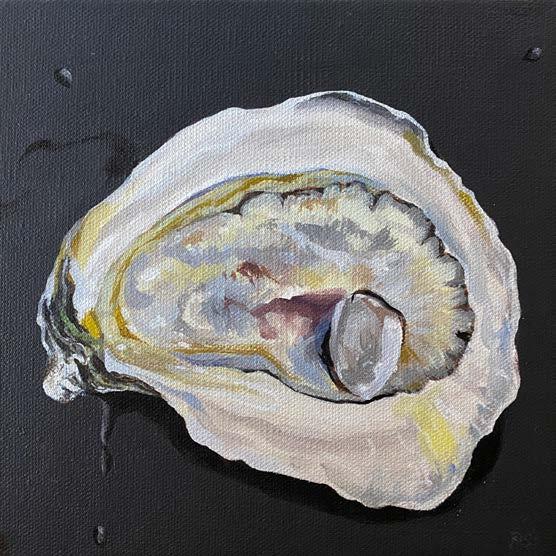
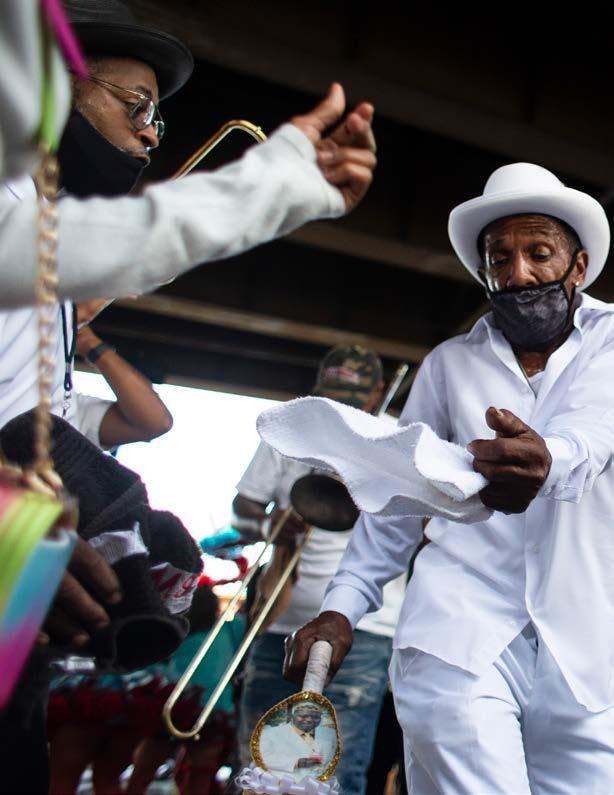
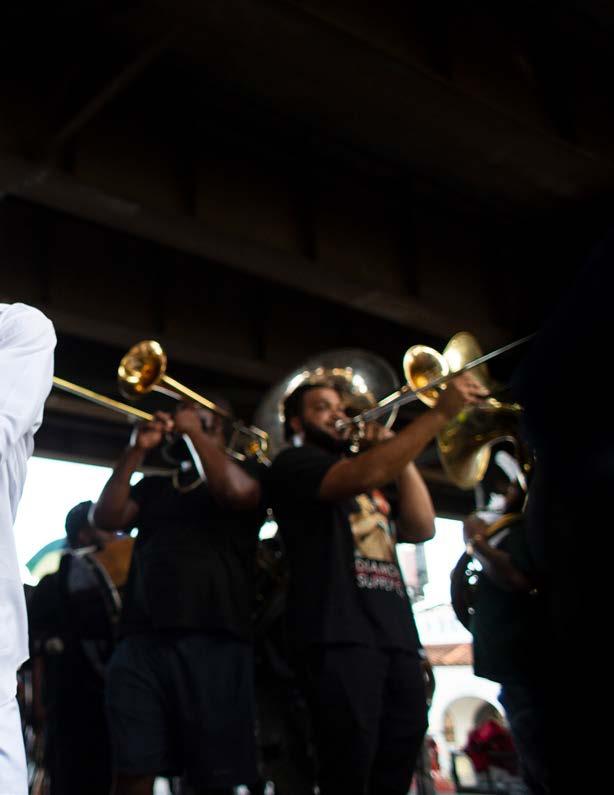

There was a party on a sylvan glade in rural Maryland roughly forty years ago. It was a Sunday afternoon, and the sound of a light rain falling on an enormous tin roof, accentuated a pastoral leitmotif. The house was a rambling structure — three stories with a wrap-around screen porch on each floor and an elevator in the middle that seemed if not incongruous, at least an eccentric addition to the early 20th century design. Yet it made the house all the more whimsical. The guests at the party were all attractive and imbued with that sense of confidence that they in fact belonged there. Yours truly did not, but no one seemed to mind.
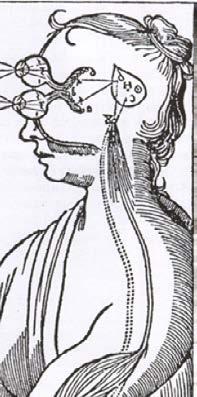
Yet I can’t find one person to corroborate the story, nor can I remember a single person at the party. The memory is more a Renoir painting than a newsreel. Perhaps it was a dream or wishful thinking. Of course, it could have happened, as part of youth is wandering into strange and fantastic places willy-nilly. But there is no verification, and the question of whether the gathering actually took place is hardly the only mystery; there are also two conundrums that beg an explanation, more universal in their significance. The first is what neuroscientists call the unitary nature of experience. I can do mental time travel and go back to that party and form a major synthesis of modes of perception — visual, auditory, and olfactory — and no philosopher, psychologist or scientist knows how this is done. Secondly and most important, the memory of that party underscores the fact that all experience is subjective. While a disinterested observer would say we are all sharing an experience at the Wyvern Club, the fact is we are all experiencing the present moment very differently, as we did the last hour or the way we will experience the next hour. And again, we don’t know why. Neuroscientists and philosophers tend to call subjective experience consciousness, and as a matter of clarity, we will go with that definition even though there are others more complex. However we define consciousness, the essential brain/mind problem continues to dog us, and while there seems to be substantial agreement that the origins of consciousness are biological, there is little proof (if at all), and as a result, there are those in the field who think the mind/brain relationship is beyond our capacity to explain. Hence philosopher David Chalmers thirty years ago coined the term “the hard problem.”
We know about brain function, the 100 billion neurons connected by 100 trillion synapses. The brain is its own universe. And we know how different regions work; for example, the four lobes of the cerebral cortex. According to neuroscientist Eric Kandel, recipient of the Nobel prize for his work with memory, the frontal lobe governs “social judgements, planning and organization of activities, … language, control of movement and a form of short-term memory called working memory. The parietal lobe receives sensory information about touch, pressure, and space around the body, and helps integrate that information into coherent perceptions.
The occipital lobe is involved with vision. The temporal lobe is involved with auditory processing and aspects of language and memory.”1 Deep in that cerebral cortex also lies the ganglia which regulates motor performance, the hippocampus which stores memory, and the amygdala which deals with emotion.2 All fine and good — but we still don’t know why or how this translates into subjective experience.
A good question that we moderns are embarrassed to ask is, is there a “ghost in the machine?” Is consciousness separate from the quotidian neural activity? Seventeenth century natural philosopher Rene Descartes thought so. Human beings, he averred, are made of two substances. The res externa is our physical stuff, including the biological brain. The brain is responsible for reflex actions and motor skills. The rescogitans are the non-physical properties that reflect the soul and our ability to reason and reflect, i.e., our subjective experiences. Descartes posited that the two realms connected through the pineal gland, a pretty good guess for a 17th century mathematician, since we now know the pineal gland regulates sleep. The theory of a bifurcated existence was embraced by the church since it reinforced the nature of the soul. Sir John Eccles, Nobel laureate neurobiologist, espoused dualism since it squared with his Catholic faith.3 Yet dualism has largely been written off by neural scientists and philosophers as new agey, anachronistic, or just unscientific.
The materialist monist argument (that the brain and mind are identical) started during the Enlightenment when Cartesian duality was put into question by a science based more on empirical observation than logic and deduction. Franz Joseph Gall, a Viennese medical doctor, argued that all mental activity is biological and different regions of the brain serve specific purposes. It was revolutionary as a thought, but science tends to go two steps forward and one step back. When Gall worked in a Vienna insane asylum, he concluded that sadists all had a bump above the left ear (I don’t know the sample size of sadists), but the next step was examining the bumps on patients’ heads and the pseudoscience of phrenology was born. Phrenology lasted well into the 19th century and was ultimately discredited, but Gall’s theory of functionality was vindicated by the study of damaged brains. For example, in 1861 French surgeon Paul Broca examined a shoemaker named
1 Eric Kandel, InSearchofMemory, (New York, 2006), 111.
2 Kandel, 45.
3 Matthew Cobb, The Idea of the Brain, (New York, 2020), 339
Leborgne, who twenty years earlier had suffered a stroke. While Leborgne could understand language, he could not speak. He died a year later, and in the postmortem Broca discovered a lesion on the frontal lobe of the left cerebral hemisphere now called Broca’s area. Upon studying the brains of eight diseased patients who had been unable to speak, Broca proclaimed, “We speak with the left hemisphere,” another breakthrough.4 Of course, the divided brain has opened a whole intellectual can of worms, with scientists, philosophers, pop theorists and public intellectuals joining the fray. Suffice it to say the left-brain/right-brain thing is very real, but some of the theories on how this plays out begs credulity.
Agoodquestionthatwemodernsareembarrassed toaskis,istherea“ghostinthemachine?”
Yet on the issue of identifying consciousness, the biological argument has come down to a matter of faith. Philosophers are invested because the hard problem deals with various branches of the field — epistemology (theory of knowledge), phenomenology (theory of experience), and ontology (theory of being). Philosopher John Searle posits with grand certitude, “Consciousness is caused by lower-level neuronal processes in the brain and is itself a feature of the brain.”5 Neuroscientists look to a biological solution simply because there is a clarity in finding the place where consciousness lies, in other words where it can be proven. This goes back to Sigmund Freud who believed his id, ego and super ego had to be based on some “organic structure.”6 It was simply a matter of time for it to be unveiled. Yet by the mid 20th century many in both disciplines threw in the towel, convinced the problem was intractable.
Nevertheless, research into solving the Hard Problem enjoyed a boost when Francis Crick of the double helix fame decided in 1976, at the age of sixty, to devote
4 Kandel, 122.
5 John Searle, TheMysteryofConsciousness, (New York, 1997), 17.
6 Kandel, 46.
the rest of his life to the “biological nature of consciousness.”7 Crick started with the materialist position that our thoughts and feelings derive from “a vast assembly of cells and their associated molecules.”8 Eric Kandel surmised that Crick’s efforts until his death in 2004 were only able to “budge the problem a modest distance,” but the method is worth noting.9 The key, Crick believed, was finding neural correlates to the unity of conscious experience. Neural correlates and unity of consciousness are both jumping-off points — correlation can lead to causation, and unity of consciousness can offer clues to the holy grail of subjective experience. Crick’s last paper, which he wrote with Christof Koch in 2004, focuses on the claustrum, located beneath the cerebral cortex. The claustrum is a connecting tissue, and according to the paper, plays the role of a conductor of an orchestra, binding neurons together. There are two problems with the theory, however. Since the paper was published, the notion of the claustrum as the engineer of consciousness has been largely disproven. And while neural correlates have been established, like cells firing when a subject was presented with a picture of a celebrity, we don’t know why the individual had that particular response, and another person would have an altogether different response.
One of the more promising ideas coming out of Crick’s research is the notion that consciousness is derived by neurons linking up in various and specific ways. Neurobiologist Gerald Edelman has argued that consciousness is widely distributed across the cortex and thalamus, with neuronal groups looping back and forth between the respective regions.10 With Giulio Tononi and Christof Koch, he has developed an Integrated Information Theory, which
7 Kandel, 377
8 Searle, 21.
9 Kandel, 377.
10 Susan Blackmore, Consciousness,AVeryShortIntroduction, (Oxford, 2017), 46.
essentially attributes consciousness to the ability of neurons to bond into a critical mass for integrating information. They have also developed a mathematical formula for explaining the process, which is well beyond my grasp.
There are also concrete experiments that evince promise regarding the amygdala as a portal for understanding the kind of brain activity that produces consciousness. When Eric Kandel presented pictures of fearful faces to a group as both conscious and unconscious stimuli, it lit up the amygdala, which activates our fight-or-flight instinct. Yet one can argue this goes back to Descartes’s res externa, since the reaction is the visceral kind rather than a reflection or musing; but it may be a start.
One of the more compelling monist theories, introduced in the 1980s by psychologist Bernard Baars, was called the Global Workspace theory. Think of the global workspace as a stage with the spotlight shining on that which we are consciously thinking about. The background is dark, but there are thoughts ready to fall into the spotlight, which can only handle so many thoughts in the foreground at one time. Every new thought enters the spotlight, and the old thought retreats into the darkness. The audience are the unconscious part of the brain. A beautiful metaphor but hardly verifiable.11
But it does raise the question of Freud’s unconscious as a biologically determined phenomenon. German neuroscientist Hans Kornhuber conducted a study in which he asked volunteers to move their right index finger. After attaching an electrode on the skull, he found that the volunteers thought about the movement for a second before they acted. He called this readiness 11 Blackmore, 48.
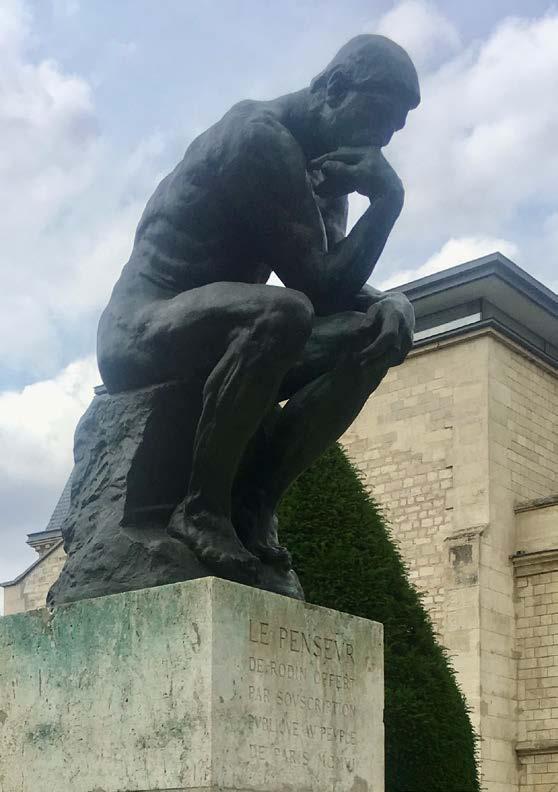 Le Penseur by Rodin
Photo by Shay Steckler
Le Penseur by Rodin
Photo by Shay Steckler
potential. Benjamin Libet of the University of California conducted the same experiment with volunteers and confirmed the readiness potential at a second before the action. Nevertheless, through reconfiguring the experiment, Libet found there is brain activity 200 milliseconds before the conscious decision to bend the finger or wrist. In other words, the mind knows things that we don’t know that it knows. Hence Libet raised not only the question of free will but brought back the dualistic ghost in the machine, which he called a “cerebral mental field.”12
David Chalmers, the rock star of the mind/brain problem, is the accepted guru of the new philosophy of mind. Chalmers made dualism respectable again and has gone after the materialists as being reductionist, or rather facile in their confidence in solving the problem through searching for elusive physical processes. The argument is that if consciousness lacks all physical qualities, then a physical or biological panacea for solving the problem is out of scientific reach. For Chalmers consciousness just IS like energy and matter,and while the brain does things that the brain does, consciousness is an added dimension.13
Which gives rise to the theory of panpsychism, a theory that consciousness is inherent in the atomic structure and therefore part of all matter.14 Human beings simply have more of it than inanimate objects and other living forms. In this case the brain acts as TV antennae or a satellite, receiving consciousness and broadcasting it out.
Two philosophers of mind, Susan Blackmore and Daniel Dennett, simply reject the notion that consciousness exists, that it reflects our own desideratum, a fantasy we want to believe. According to Blackmore, “Consciousness is an illusion: an enticing and compelling illusion that lures us into believing that our minds are separate from our bodies.”15 For Dennett the whole question comes down to human evolution; a combination of biological evolution, brain plasticity and finally cultural evolution (in which I don’t have to reinvent the wheel myself) have allowed us to thrive. The brain is our hardwiring and processes all the information that comes in (i.e., the software). According to Dennett, “human consciousness is a huge complex of memes [impressions] …that can best be understood as the operation of a von
12 Cobb, 356.
13 Blackmore, 45
14 Searle, 156.
15 Blackmore, 130.
Neumannesque virtual machine…”, alluding to mathematician and physicist John von Neumann, along with Alan Turing, inventor of the computer.16
Mathematician Sir Roger Penrose and scientist Stuart Hameroff claim the computer analogy is not even metaphorical, that tiny microtubules found in brain cells are in fact quantum computers that create coherence with information coming in.17 The notion of the brain as a computer has many adherents, and that’s a rabbit hole I avoided. But there is a certain irony in the great hope of Artificial Intelligence, that by building a machine that could achieve singularity (consciousness), it could prove the materialist right, assuming the machine replicates functionality of the brain. It could also settle the monist/dualist controversy for good, forever relegating Descartes to the guy who tortures sixteen-year-olds with Algebra II.
Yetontheissueofidentifying consciousness,thebiologicalargumenthas come down to a matter of faith.
But there is too much out there that defies reductionist materialist theories. We settled the question that experience is subjective, but that does not exclude psychic connections between people. After all, that’s what leads them to the altar (or a hotel). I woke one morning to a feeling of profound ineffability, yet it was peaceful, even perhaps exhilarating. I later found out from my friend’s aunt that he had died at that time of an awful cancer. He had also suffered from mental illness since his early twenties. He was a prince of a fellow and escaped the shackles of this earthly existence. This kind of experience, while not verifiable, is not uncommon. I hardly think brain matter, or a computational network, can achieve this.
My conclusion is that Descartes’s ghost in the machine is no more preposterous than biological materialism or even panpsychism. What if consciousness drives brain activity or that brain activity is a conduit to a level of thinking beyond
16 Daniel Dennett, ConsciousnessExplained, (New York, 1991), 210.
17 Blackmore, 45.
the physical self? My friend DeGioia is college president by profession but a philosopher by training. According to his tenets of philosophical thinking, when we face a hard problem where there is no clear way to navigate the essential question (like what is consciousness?), our only solution is to make a choice. And not making a choice is a choice and perhaps the wisest one. But for those of you who like me cannot avoid this question, which gets to the essence of our human existence, I wish you Godspeed and good luck.

One of my greatest thrills as a new parent is bonding with my child over music. I inherited a stack of CDs from the Mileys titled Rockabye Baby: a series of rock classics translated into lullabies with tubular bells and xylophones. Scratched, scuffed, torn, and taped, this archive has been clearly loved over the years. Every day at 4:45, I pick my daughter up from daycare, pop in a disc, and begin her music education. Here is an abridged ranking of some hits and misses from the collection. ClickonthebabysleepingonthemoontolistentothesongonYouTube.

4 5
Nirvana - I had high hopes for this album. Acoustic interpretations of Nirvana are limitless, including their own legendary MTV Unplugged in New York and Patti Smith’s rich, playful, banjo-based cover of “Smells Like Teen Spirit.” Slowed down and tapped on a marimba, Nirvana somehow feels both lethargic and unsoothing. One rattle.
Nine Inch Nails - Trent Reznor is a versatile artist unafraid to bend genres, so I expected his music to lull more gracefully. This haunting interpretation is better suited to the Exorcist soundtrack than a nursery, and it was hard to reconcile the lyrics that played in my head. “Head like a Hole” works better than others when paired with lyrics from the Miley Cyrus Black Mirror collaboration: “I’m full of ambition and verve, I’m going to get what I deserve.” Two rattles.

3

Guns N’ Roses - These rock anthems pleasantly surprised me as lullabies. The shrieking vocals and electric guitar slash through a music box and emerge innocently cheerful arrangements. They also peppered in some chirping and croaking, showing not telling us we’ve reached the “Paradise City.” Three rattles.
Pink Floyd - These covers drifted readily into dreamland, and the melodies and lyrics contain multitudes of emotion. The ticking clocks and resonant chimes from the opening of “Time” sync up seamlessly when played in unison with the original, as if both were written for The Wizard of Oz. “Wish You Were Here” is a bittersweet ode to attachment and object permanence, two concepts we all must reckon with in our early years. Four rattles.

2
1

Pixies - This album has something for everyone. “Monkey’s Gone to Heaven” has a fun counting segment. “Debaser” provides an opportunity for chanting French nonsense wrathfully or gleefully, depending on the mood of the day. “With your feet on the air and your head on the ground,” singing “Where Is My Mind” in unison with a screaming baby is a quintessential early parenting moment. Five rattles.

Butters will turn eighty-four next month. She has been deaf for the last twenty years of her life, and recently her vision has begun to falter. When the cold air of this past winter arrived, her back became arched and crooked and her walk more delicate. Her legs wobbled and quivered in the first few hours of every morning. With the warmer weather, her balance has improved, but she still struggles with standing and supporting her own weight. Her roommate Omar is seventy-eight. He still moves well, but his hearing is also fading. He no longer notices when Butters rises from her bed in the morning and waddles gingerly down the hall to begin her day with a drink of water before breakfast.
My wife and I have been taking care of Butters since her original family abandoned her a number of years ago; Omar has been with us since his mother in Mississippi decided to give him up for adoption shortly after his birth.
Butters and Omar are our two Shih Tzus, and their lives are coming to a conclusion. Like many their age, Butters and Omar have their good and bad days, the difficult ones characterized by excessive bouts of sleeping, sometimes nearly twenty hours a day. On these days, Butters will get out of bed to urinate on the kitchen floor before returning to her bed of choice. She has three now, one in the TV room, one in the bedroom, and the other one in the office with the heating pad. It’s been a good ride, but they’ve both entered the twilight of their lives, and my role has changed from one of trainer and adviser to caretaker and nurse, trying to provide a warm, comfortable environment for them to live at peace during their final years, as we all brace ourselves for the inevitable.
Each day, their health declines. Omar struggles to jump on the couch now. Butters needs to be carried down the porch steps. Omar’s back legs shake. Butters stares vacantly for extended periods at the bottom of the refrigerator. During these moments, I’m reminded of a line at the end of KingLear. Kent, Lear’s loyal servant to his final hour, gazes in disbelief at the numerous lifeless bodies strewn about the stage as Lear enters holding the limp body of his favorite daughter. “Is this the promised end?” Kent asks Lear’s son-in-law, Albany.
Sometimes I ask this directly to Omar, but he can’t hear me anymore, and Butters is too busy mindlessly licking the floor to bother to acknowledge me.
On the morning of Boxing Day this year, Omar woke up wheezing and coughing, struggling to catch his breath, and it was evident that what we'd thought was merely a respiratory infection was something far more serious. We took him to the emergency vet, and after various tests, bloodwork, and an overnight stay, we learned that Omar had congestive heart failure, a common ailment for small dog breeds. With medication, they told us, Omar could live another six to eighteen months. The north damp wind blew steadily the next day when we picked him up, and a feeling of dread pervaded the car as we drove past the faceless chain stores and naked trees on the way back to our house. After an oxygen treatment, Omar appeared calm and thankful to return. He settled into his chair. I put his medicine on the kitchen table, and my wife cleaned up the puddle of Butters’ urine in the living room.
Butters remained unfazed by the recent news of Omar’s condition. I envied her inability to understand that, as John Irving wrote at the end of The World AccordingtoGarp, “we are all terminal cases.”
I was afraid that this might happen when my wife originally brought Butters home in January of 2020, a couple of months before the world shut down. Her original elderly owners could no longer care for her and put her up for adoption. I never agreed to take in this dog. It was January. The dog was twelve. “Maybe she lives a year or two, just enough time to form an attachment, and then…,” I said to my wife. “Omar is getting old, too. It seems that we are setting ourselves up for unnecessary sorrow.” I said that on a Sunday. On Monday afternoon, Butters was sleeping on our couch and a new dog dish had been added next to Omar’s.
She didn’t answer to Butters back in those days. She didn’t answer to any title because she was already deaf when we got her. Her birth given name was Diamond. My wife and I didn’t want our dog to be mistaken for an exotic dancer, so we changed her name. Diamond came with papers from the American Kennel Club and a box of clothes, including dog booties for walks on rain-soaked sidewalks and an LSU sweater for football season. Apparently, she had lived a pretty charmed life.
“You’re Butters, now,” I told her. “Welcome to retirement.”
Like many of us during those early months of the pandemic, Butters had an unsettling 2020 and a difficult time adjusting to her new life. Zoom meetings and masks had nothing to do with Butters’ unease, though. It was adjusting to her new Uptown life after spending her entire existence with her family in Gentilly that was at the root of her anxiety. The Prozac our vet prescribed seemed to put her at ease, and, eventually, Butters began to embrace each first day of the rest of her life.
Two years ago, our vet, Dr. Woods (not his real name), made another discovery that also had a significant impact on Butters’ quality of life.
“I think she’s in an incredible amount of pain because of her teeth. Many are loose, and some are clearly decayed,” he said. “I think we should pull them.” Butters went to sleep and woke up with twenty-six fewer teeth, but Dr. Woods insisted that this was the proper decision. “She’ll feel so much better,” he assured us. “I think I may have bought her an additional two years of life.” At this point, Butters’ incontinence had already become an issue.
“We better stock up on a few more old dish rags,” my wife said.
“Yep. I guess we’d better,” I replied.
Our vet has known Omar since he was a puppy. A friend originally recommended this doctor because of his naturally calm demeanor and his tender, mild-mannered disposition. “He loves animals so much, and he reminds me of my grandfather,” she told us. “You'll love him.”
That was over twelve years ago, seventy-eight in dog years. When Omar approached middle-age, Dr. Woods used to scold us about his weight. “He’s one and a half pounds overweight. That’s like you gaining twenty pounds in two years,” he’d tell us.
My wife would get defensive. “He goes on two walks twice a day,” she’d tell him. “We do give him people-food but only carrots and celery and the occasional mushroom.” With a partially raised left eyebrow, our vet would just listen incredulously before changing the subject. Upon leaving, I’d tell my wife not to

worry. I’ve gained a few pounds since the last visit as well. We’re middle-aged now. I understand what Omar’s going through.
“Omar’s not fat,” I’d finally say as we approached the car. “He’s just big-boned.”
Besides the occasional fat shaming, Dr. Woods has treated Omar and us well over the years. We used to see him twice a year, but because of Omar’s recent diagnosis and Butters’ overall decline, we’ve been going to the vet once a month now. I’ve looked at my dogs differently in their later years, but recently I’ve noticed some changes in my vet as well. His hair has thinned. He has begun using a cane when he walks into the waiting room, and, during this last visit, he repeated a key phrase numerous times when giving us specific instructions for administering Omar’s meds. This worried me.
“Are you hearing me? The Dioxin he gets twice daily. Just give him the Pimobendan once a day and only a half tablet of the Spironolactone every other day. Are you hearing me?”
“Yes, sounds good,” I answered.
“Remember, this is not a cure, but only a treatment. Are you hearing me? This will just buy him some time. Are you hearing me? It will not shrink his heart.”
I heard you. Omar’s practically deaf now, so I’ll let him know, and I’ll be sure to tell Butters after she stops staring at the wall and licking the carpet.
That’s my life these days, mopping up dog piss and washing out old dinner towels and placing them in our canvas bag in the laundry room devoted to this new task in my life. I wake up, get ready for work, clean up puddles, then walk out the door. My wife is an occupational therapist at a nursing home, and her work life and home life seem to be blending now. I’m not entirely sure how she copes. My upper school students may be noisy at times or uninterested or distracted or sometimes even asleep when I’m teaching. Most of them remember my name, though, and at least they’re able to use the bathroom without any outside assistance.
Growing up in New England, I became a Boston Red Sox fan as a kid well before they started winning World Series titles and enjoying any success. During the final game of the season, the radio announcer would read a passage from the late Bartlett Giamatti, former president of Yale and the baseball commissioner best remembered for banning Pete Rose from baseball and the Hall of Fame for gambling. Giamatti’s essay, “The Green Fields of the Mind,” is about listening to baseball on the radio as a way to stop the inevitable passage of time. More specifically, he writes about the last game of the 1977 season when a Red Sox win would assure them a tie for first place with the Yankees. As long as the Sox season continues, he writes, “school will not start, rain will never come, sun will warm the back of your neck forever.” When the Red Sox lose the game, Giamatti writes about baseball leaving us to “face the fall alone.” Giamatti had just turned forty when he penned this piece and mentions how “there comes a time when every summer will have something of autumn about it.”
It is spring now, but I’m beginning to understand. Omar’s on the couch sleeping soundly. Butters is in her third bed that’s been moved to the screen porch for the warmer spring weather, and Dr. Woods is probably prescribing medicine to an aging pitbull. I flip my calendar to April and glance past Butters’ bag of dish rags to the top shelf that holds Omar’s pill bottles. There’s November over by the dryer, lurking in the shadows, with a smirk on his face, reminding me of what awaits when the seasons turn and the final out is recorded.
“Are you hearing me?” he asks.
I do, but summer is coming, and Omar needs his second dose of pills for the day, and the refrigerator is just too damn intriguing for Butters to stop staring now. Fall will have to wait.
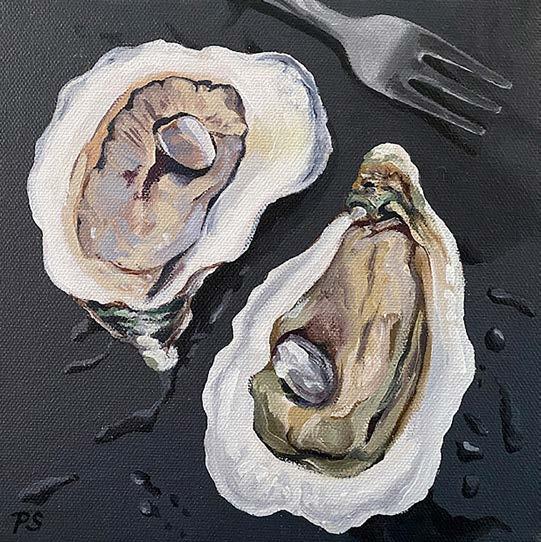


The first thing you might notice about the spore blobs floating toward Earth is they look a little coronaviral. Settling into a variety of botanical forms, they quietly but efficiently take over the San Francisco landscape. We zoom in on a playground, where a teacher is encouraging the children to pick the pretty red flowers and take them home. A priest on a swing glowers at the group, and the priest is Robert Duvall. The camera shifts to his POV for a second, and then we never see Robert Duvall again. This odd little cameo is the first of many disorienting details in InvasionoftheBodySnatchers, an underappreciated sci-fi classic that builds horror not by showing us alien monsters (though there’s a bit of that) but by taking the utterly familiar and tweaking it just so. You think you know Robert Duvall but you don’t.
Our heroine is a Department of Health lab worker named Elizabeth (Brooke Adams), who plucks one of these invasive plants and brings it home to show her cuddly but sports-distracted boyfriend Geoffrey. (You know this is the ‘70s because Elizabeth and Geoffrey own a lot of macrame plant hangers.) The next morning she wakes up to find Geoffrey acting very different — cold, distant, and wearing a three-
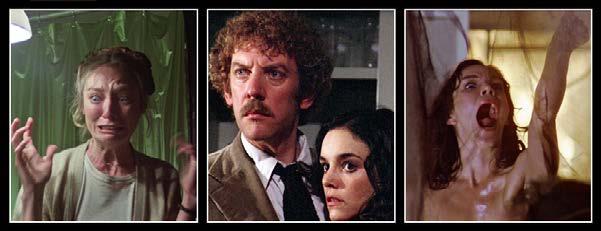
piece suit like a total square. He takes a curious bundle of garbage out to a waiting sanitation truck and spends way too much time watching it get compacted. Elizabeth tries to embrace him but recoils at his sudden stiffness.
Donald Sutherland plays Elizabeth’s colleague Matthew, a health inspector who’s first seen harassing a restaurant’s kitchen staff after finding a rat turd (his words) in the stock pot. Elizabeth invites herself to Matthew’s place for dinner and asks him a question that takes on extra layers of meaning as the movie progresses: “Do you think it’s true that if you think you’re losing your mind then you’re not?”
She explains that Geoffrey is not himself and that she means it pretty much literally. Matthew assures Elizabeth that he doesn’t think she’s crazy but insists that she “do that thing with her eyes” to prove it. Then she does this CRAZY vibrating thing with her eyeballs that is not CGI because this is 1978. (Brooke Adams may be our most underrated actress.) They laugh and drink more wine, and we can tell they have a bit of a thing for each other. Matthew and Elizabeth are thus established as smart, funny, relatable characters who have real chemistry. Somewhere in the multiverse, this movie is a romcom where they spend the next eighty minutes overcoming the boyfriend obstacle, and everything falls nicely into place.
But in this world, things get very weird very fast. Everywhere she goes, Elizabeth encounters blank, impassive faces; people on the street walk in eerie silence, carrying strange bundles and registering zero emotion, as if part of a vast conspiracy to be maximally boring.
Matthew too has a strange encounter when he drops off his dry cleaning and discovers that his affable charm is suddenly lost on the newly apathetic Mrs. Ting. Her husband takes Matthew aside and tells him his wife is different. “That's not my
wife,” he keeps insisting. Matthew is puzzled but doesn’t think much of it, the first of many times we see him rejecting the evidence of his own eyes.
At this point, we’re noticing that everything looks and sounds a little off. The plants are green but also a touch grayish, their buds a bit aggressive and a little too bright. And they’re everywhere – reflected in mirrors, viewed through shop windows, sitting on office desks, dotting the landscape. The macabre lushness is accompanied, for optimal cognitive dissonance, by sound mixing that’s awash in industrial white noise. There are near-constant machine sounds: dry cleaning equipment, a floor buffer, a car alarm, the churning sanitation trucks that are suddenly showing up everywhere, day and night. Now and then we get a moment’s relief in a bird chirping, a snippet of music on a hi-fi, the banjo plucking of an old hippie sitting on a park bench with his dog (more on them later).
As Matthew drives Elizabeth to a book party, his car is assaulted by a hysterical man who screams, “They’re coming! They’re already here! You’re next!” The man is chased through the street by a silent mob and struck down in traffic. As affectless bystanders stand over his lifeless body, Matthew says, “The police will help” and drives on. Matthew’s faith in the benevolence of authority figures will take several turns for the worse as the movie progresses.
The book party is for Matthew’s celebrity psychiatrist friend Dr. Kibner, played by a cunningly cast Leonard Nimoy as a paternalistic asshat, a font of psychobabble who’s telling a distressed patient who suddenly fears her (not) husband that she’s being irrational. Knowing
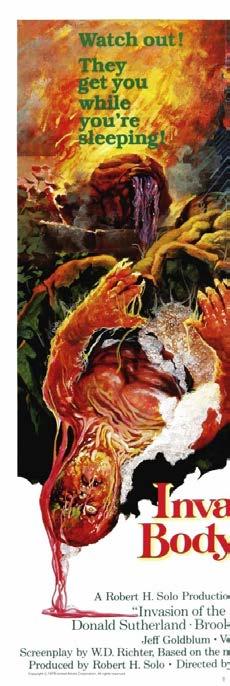
exactly how this woman feels, Elizabeth tries to reach out to her, but Dr. Kibner intervenes. He’s been hearing these complaints and says it’s just some kind of “hallucinatory flu” that people get over “in a day or two.” He suggests to Elizabeth that her little Geoffrey problem is just a projection, that her boyfriend is the same as ever, and it’s really herfeelings that have changed. (Brooke Adams is great at showing you how hard she’s trying to make herself believe this.)

Also at the book party is Jeff Goldblum, who plays Jeff Goldblum Matthew’s friend Jack, a neurotic struggling poet who runs a mud spa with his New Agey wife Nancy. Jack sees Dr. Kibner for the quack he is, but mostly he’s jealous of the guy’s publishing deal. After a weird skirmish with Kibner, he goes home to have a lie-down in one of the massage booths as Nancy attends to a Rasputin-looking client, thanking him very much for the nice plant he gave her. Later, she goes looking for Jack and finds, in another booth, the supine figure of a half-formed humanoid thing that looks like it’s covered in Extra Hairy Saran Wrap. Screaming maniacally, she wakes Jack, and the freaked-out couple call Matthew in to have a look. He examines the creature and senses it has some connection to the similarly tall Jack. He tells Nancy not to call the police (good!) but to call Dr. Kibner instead (bad!). Then he figures out that Elizabeth might be in trouble and springs into action (good!).
Here the movie crosscuts between Matthew’s super-stealthy rescue of Elizabeth and the further adventures of Nancy and Jack and Jack’s pod (let’s just go ahead and call them pods). Matthew breaks into Elizabeth’s house, bypasses her stillforming pod, and gets the real Elizabeth the hell out of there, right under the nose of the now-
very-logical but still-somehow-dumb Geoffrey. Back at the spa, Jack and Nancy have another close call with the pod and dash toward the exit just as Dr. Kibner arrives, now cutting every bit the sinister figure we always knew he would.
Dr. Kibner goes to have a look around and comes back to inform them that he can find nobody! Sure enough, the place is empty, but now there’s a window open with a garbage truck agitating just outside. Strange!
Fast forward to everyone holed up in Matthew’s apartment as Dr. Kibner tries to convince Matthew and Elizabeth and Jack and Nancy that, don’t be silly, nobody’s beingreplicated. Leonard Nimoy achieves an ingenious balance of therapeutic unctuousness and Spockian detachment as he tells everyone he’s “just trying to help.” And then, just in case we weren’t absolutely sure what was up with Kibner, he gets in a car with Geoffrey and a known pod enforcer, saying “The sooner the better.”
Nancy and Elizabeth finally figure out that the parasitic flowers are the through line in this pod situation, with Nancy going so far as to say she thinks they came from outer space. Jack is skeptical, and if your brain can faithfully summon Jeff Goldblum’s aura, the following exchange is very funny.
Jack: What are you talking about — a space flower?
Nancy: Why not a space flower? Why do we always expect metal ships?
Jack: I’ve never expected metal ships.
Of course, we know that Nancy is spot on, but she goes on to assert that spacemen mated with apes to create the human race, so her credibility takes a nosedive. Let me mention here that Nancy is played by Veronica Cartwright, whose eyes almost rival Goldblum’s for magnetic bugginess and who is adorably intense in this movie.
Matthew tries and fails to file reports with various agencies who alternately humor him, stonewall him, and hang up on him. “People are returning to normal,” he’s told (with “normal” left conveniently undefined). At the dry cleaners, Mr. Ting informs Matthew that his wife is “much better now.” The hysterical woman from the bookstore calmly tells Elizabeth, “I’m back to myself again.”
That evening, despite having almost been murdered/duplicated (murdicated?)
in her sleep, Elizabeth accepts a sedative from Dr. Kibner. (You read that correctly.) As Matthew dozes off outside, four pods start to grow and undulate. When they finally crack open and expel their unholy replicants, the special effects achieve a record high on the Cronenberg Slime Index, accompanied by sound mixing of surpassing moistness.
Nancy frantically runs around waking everybody up, and I’m sorry to report that Matthew, um . . . calls the police? The voice on the other end says, “Wait right there, Mr. Bennell.” (He didn’t tell them his name.) Still clinging to that last shred of faith in authority, he tries to phone one of his Washington contacts as the other three tell him not to bother because they’reallpodsforchrissake.
The police arrive and begin their pursuit, along with a plainclothes pod mob. As his friends bolt, Matthew tries to kill the four pods, but the pod mob shows up pointing and shrieking at him, which we understand to be the “signal.” How to describe this shriek? Like a demon-possessed kookaburra with extra reverb? Words fail.
Matthew rejoins his friends as the pod mob continues to run, point, and shriek after them for many minutes on end. Jack heroically opts to decoy himself, giving Nancy one last kiss before running wildly into the street screaming, “Come and get me, you scum!” A forlorn Nancy trails after him.
Matthew and Elizabeth figure out that if they’re going to survive they have to hide all signs of human emotion. They stoically make their way through the red-light district, where a handful of filthy-minded non-pods are still skulking into nudie shows (making this, as far as I know, the only film where strip clubs represent the last hope for humanity). They end up hiding out in Elizabeth’s lab at the Department of Health, where they take some non-recreational speed and declare their love for each other. Outside, pod officials are directing newly minted pods as they line up like sheep to discard the remains of their former hosts.
The whole pod-friend contingent barges into the lab — Dr. Kibner and Geoffrey, of course, but also Jack, who despite now being an emotionless pod betrays a hint of Goldblumian peevishness when he says, “It would’ve been a lot easier if we’d just gone to sleep last night.” Aided by a couple henchmen, Kibner injects Matthew and Elizabeth with a sedative as the pod trio talk about how great pod life is:
Geoffrey: Nothing changes. You can have the same life, the same clothes, the same car.
Elizabeth: But what happens to us?
Kibner: You’ll be born again into an untroubled world. Free of anxiety, fear, hate.
Jack: Your minds and memories will be totally absorbed. Everything remains intact.
We know that Jack is no longer really Jack, but we can’t help being disappointed that he’s now so capable of bullshitting people. Either the mind is the brain, which processes emotion (science!), or the mind is some kind of disembodied spirit — and since the pods demonstrably lack either emotional or spiritual animus, Jack is straight up lying about everything remaining “intact.”
Kibner further extolls the virtues of podhood in his lifestyle-guru way, explaining that they’re “evolving into a new life form” as if that’s a selling point, and finally lays out the whole body-snatcher project in full: “We came here from a dying world. We drift through the universe from planet to planet, pushed on by the solar winds. We adapt and we survive. The function of life is survival.”
He barely gets this last depressing sentence out before Matthew knocks him unconscious, kills Jack with a dart, and flees with Elizabeth. (Geoffrey and the henchmen have conveniently stepped out to have one of their boring meetings.) They encounter a poker-faced Nancy on the stairwell, and for a few seconds the three of them have a very intense staring contest: Is Nancy a pod? Does she think they are pods? Finally poor Nancy breaks down in tears, and a group hug ensues. The three friends make their way through the pod sheeple, trying not to show emotion.
Their plan is foiled in the most ghastly way when a dog scurries up to them with the face of its hippie-banjo-player owner fused to its body, the result of pod damage. (This moment is scored to banjo music as a kind of comic-relief callback, which I lean towards thinking was the wrong choice.) As this sick mutant AIgenerated-looking hybrid licks its humanoid chops, Elizabeth cries out in horror, tipping off the pods. Soon she and Matthew find themselves chased by an all-new mob of shriekers. Nancy sensibly stays behind and continues blending in.
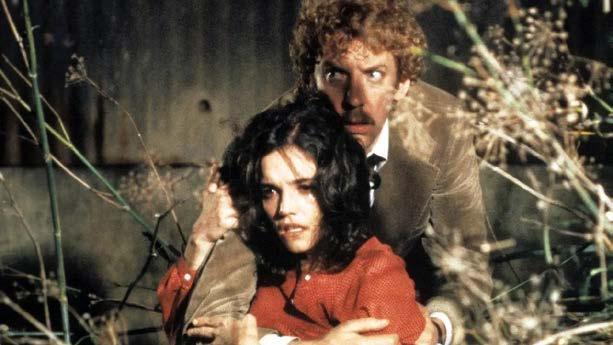
Matthew and Elizabeth make another nifty getaway and end up at the pier, where it just so happens pod plants are being cultivated in a giant warehouse. The couple reaffirm their love for each other in a “this is the end” kind of way, but hope reanimates when they spy a ship pulling up to the dock as a loud-as-hell bagpipe plays “Amazing Grace.” Leaving Elizabeth behind to scope out the situation, Matthew runs toward the dock, the music swells Spielberg-style, and there’s a goosepimply moment when we think these wretches might actually be saved.
But no. Matthew is heartbroken to see a crane loading pods into the ship; San Francisco being pretty much conquered, pods are now an export business. The hymnal dissolves into shifting radio frequencies and finally a weather report. Hopes dashed, Matthew returns to find Elizabeth asleep, on account of how easy it is to doze off to bagpipe music.
This next part is hard to watch. Matthew tries to wake Elizabeth, but she’s already showing signs of decay. He embraces her one last time as her face vividly
implodes and her body crumbles into an exoskeletal heap. Readying himself for a full-throated cry of anguish, he turns to find a brand-new, naked Elizabeth standing before him. “There’s nothing to be afraid of,” she says in a zombie-like monotone as Matthew flees. “They were right. It’s painless.”
Matthew sneaks into the pod warehouse and, in a great action scene, burns the whole place down, destroying like fifty Home Depots worth of plants. Elizabeth IDs him by pointing and shrieking, but he once again evades capture. As he hides under a bridge, one of his pursuers shines a flashlight just past him, muttering, “He can’t stay awake forever.” We nod in grim accord with this pod person: Matthew’s adrenaline has worked admirable overtime, but he is under sedation (thanks Dr. Kibner!).
In the next scene, it’s a beautiful day on Grove Street as Matthew enters the Department of Health. We don’t know how much time has passed. A voice on a loudspeaker delivers a stream of coded announcements that we understand to be more or less endless. Matthew watches Elizabeth as she adjusts a beaker, her movements like a series of tableaux. We’re trying to read his face, which seems pensive, maybe even a little sad. Has he somehow managed to stay unsnatched? In his office, he meticulously cuts a clipping from a newspaper. (Is it a coupon? We don’t know.) He takes the elevator. He walks outside.
A voice calls to him; it’s Nancy. There’s a question in the way she says his name, as in “Are you still Matthew?” She cautiously approaches him, but her face is hopeful, a hint of a smile playing on her lips. There is a beat. Then Matthew’s face opens wide as he releases a long, piercing kookaburra shriek and extends a j’accuse finger at the horror-stricken Nancy. The camera moves forward and forward, and you think there’s no way it’s going to actually enter Matthew’s gaping hole of a mouth, but then it does. Credits roll. Goodbye Matthew, Elizabeth, Jack, Nancy, and the whole doomed human race.
If you choose to watch this film now that I’ve spoiled the whole thing, you should know that the experience is likely to be every bit the total bummer it sounds. A remake of the 1956 sci-fi classic (which had a studio-imposed happy ending), this version occupies a special place in the 1970s pantheon of paranoia, and in the decades since I think only Lars von Trier has matched its apocalyptic vision.
In the ‘56 version, the pod people were said to have represented, depending on who you asked, either McCarthyite red hunters or Communist invaders, and I spent a minute or two trying to figure out what the 1978 political parallels might be. But then I decided you don’t need politics or history to understand why this premise still resonates. The pod takeover is an enactment of our worst nightmares, tapping into fears we’ve nurtured since achieving consciousness — the familiar turning hostile, our protectors turning predatory, our loved ones turning against us. Add to that a world thoroughly drained of humor, joy, spontaneity, and feeling. Toss and serve.
This movie is so darkly pessimistic, so rigorously nihilistic, that it may surprise you to learn that my husband feels a cozy kind of nostalgia for it. He and his friends saw the first run of the film as sixth graders, and the pod people’s point-and-shriek move was so imprinting that the kids co-opted it as a hallway greeting for the entirety of the 1978-79 school year.
Because you are probably normal and not in sixth grade, you almost certainly won’t have similarly warm and fuzzy memories of the film. But there may be something to salvage. You’ll come away shaken, all right, but also maybe, maybe a tiny bit grateful — for the untidiness of your life, for your spouse’s irritating habits, for your teenager’s mood swings, for your students pointing and shrieking at each other in the hallway, for all the extremely human things that make you wonder whether it’s true that if you think you’re losing your mind then you’re not.

Delia keeps an eight-minute mile and smiles at the storm-ravaged former golf course. City Park, one year after Katrina, is more African savannah than recreational public space. The tall grass and weeds sway in the breeze, the colorful parrots caw on Spanish Moss strewn branches, the coyotes stalk tiny designer dogs on nightly walks. A Cajun trapper was recently hired to track and kill the burgeoning wild boar population. Before the storm, New Orleans seemed mythical, on the edge, barely even America. Now it’s a combination of the Wild West and the jungle.
Nature’s coup d’etat extends beyond the park too. Green pops up between the cracks in the sidewalks of Delia’s blighted neighborhood, just a mile outside the French Quarter. Vines crawl up the walls of the wrecked shotguns. It’s beautiful, verdant, this reclamation. She will blog about this later. The Post-Apocalyptic Aesthetic, The Post-Civilization Ideal, Disaster Chic, she repeats possible titles to herself while running on the barely paved path, eyeing the ground lest a root should trip her.
Deeper into the park between Robert E. Lee and Harrison Avenue, she sees fewer people. Ryan, a fellow volunteer, usually runs with her, but he’s helping a local with car trouble. Delia and Ryan rarely say no when asked for help, which means they cook for the crew, gut houses, do yard work, fill out Road Home applications, and tutor fourth graders at a failing elementary school three days a week. She’s wiped, but she needs to counter her diet of beer, fried seafood, and beignets.
It’s eerie running alone, but Delia didn't come to New Orleans from Glenview, Illinois for safety. After work, when she’s a little drunk and a lot honest, she calls this interregnum between degrees her “quest for the authentic,” and authenticity requires a little danger. She never mentions her quest to locals, but the other volunteers from places like Shaker Heights and Denver understand the thrill of being in the City Care Forgot, especially after being in more competent, boring places their whole lives. On their last run, Ryan said he didn’t know how he’d ever go back to Grand Rapids. “It’ll feel so banal, so colorless, you know?”
Now, running solo, listening to some playlist Ryan made her, Delia calculates if she keeps her pace, she’ll just beat the sunset. She doesn’t want to push her luck. She turns up the volume, and before long, her thoughts drift to what happened yesterday.
It happened during her nonprofit’s morning cleanup session. At the rebuild center, Delia and the other volunteers grabbed giant, industrial-strength bags, gloves, and masks and took to the streets, picking up trash and clearing the overgrown weeds. A few months earlier, to mitigate the ick factor of the chore, the crew attached a point system to the discarded items: 2 points for diapers, 3 for soiled tightie-whities, and 5 for used XL condoms. Delia and her cohorts keep the game from the college students, church groups, and company-sponsored volunteers who see each baby’s toy and unopened box of tampons as evidence of ruined lives and secret horrors. Delia used to do this too, create totems of detritus, but the romance has worn off.
Sometimes Delia misses the frisson she got the first few months when she picked up a moldy Irma Thomas record, an errant baby shoe, an unopened bottle of Drakar Noir, but she understands that this loss is what delineates her from the temporary volunteers and the bead-wearing tourists, the drunken buffoons. Like the UVA frat boy who, that very morning, had the undeserved good fortune to find a bonafide New Orleans treasure in an abandoned, gutted shotgun.
Delia didn’t like him from the start. She could differentiate the earnest, idealistic do-gooders from the kids whom she would hear about later, puking and pissing their privileged asses all over Bourbon Street. She was sure this “Chad,” she refused to learn his name, would be clutching a Hand Grenade and calling out for boobies by noon, happy in his natural habitat. Delia noted that Chad did not grab a mask or gloves before heading out, and haphazardly stuffed the end of a single garbage bag into the back pocket of his cargo shorts. Cargo shorts, Delia smirked, the sartorial signifier of stupidity.
The volunteers walked down Palmyra to Banks Street where the old Dixie brewery stands. Delia, Ryan, and other crew members gathered their gaggle of volunteers and briefed them on the cleanup. They needed to work in pairs because the neighborhood was still “recovering.” Recovering was code for dangerous. To assuage their anxiety, Delia told them that she lived just two blocks away. They always looked a bit shocked, concerned even. She enjoyed this response.
When Delia told her friends back home about the crack dealers two houses down from her who fought rottweilers and the schizophrenic man who took time out of his busy schedule to inform her, every single day, that he was going to rape
her, they gasped and told her to come home. Delia explained that these people have undergone a serious trauma, not to mention the horrific public school system, and a history of disenfranchisement. They are victims; expecting more from them demonstrates a Western competence bias, she reminded her friends and family safely tucked away in their bubbles.
The UVA kids looked wary of the quiet, abandoned streets: the errant teenager riding a bike in slow circles, the silent stares of a few residents sitting on their porches. Delia liked their discomfort; maybe they’ll learn something today, she thought. To her mind, Chad did not look uncomfortable enough.
After directions were given to the students, the groups broke off into twos, covering a six-block radius of the Tulane-Gravier neighborhood. Each pair had their bags, maps, and walkie-talkies. They planned to reconvene in two hours then head to the Lower Nine for a tour of the devastation. A few months ago, Delia told her boss she’d rather stay behind to protect her mental health. But that wasn’t the truth. The truth was she stopped feeling anything on these tours, other than annoyance.
During the last tour she led, two neighborhood kids hopped on the bus and asked everyone to buy candy bars for their school band uniforms. She asked them to leave, but they pretended not to hear her, refusing to get off the bus until tourists forked over some cash. Apparently, this happened all the time now–locals soliciting the tourists. Delia felt the blatant capitalist money grab polluted the experience of bearing witness.
Across the street, Ryan worked with Chad, and Delia worked with a young pre-med student named Madison. Madison was quiet. She did not shriek at rats or refuse to pick up dirty diapers like many female volunteers. While Delia considered
herself a strident feminist, she found most women tiresome and preferred the company of men.
Ryan and Chad, mostly Ryan, took one side of Banks Street, and the girls took the other. It was 8 a.m. on a Saturday and already warm. The humidity made Delia’s wiry hair crooked with moisture. She had taken to wearing a discarded trucker hat, pulling her blonde hair through the hole in back. New to the subtropic sun, Madison struggled, her sweat painting a giant Rorschach inkblot on her back. Chad was not sweating. Not one bit.
After the first forty-five minutes, Ryan and Chad were an entire block behind the girls. Ryan was too nice for his own good. He insisted that everyone wanted to do good, deep down, but Delia knew better. Chad was immune to Ryan’s insistent requests for help: “Hey, could you help me roll that tire into the street?” and “Do you mind picking up some trash, buddy?”
Ryan had a habit of letting stronger, more aggressive men push him around. The mold mitigation crew leaders ribbed him about being a lightweight, a real “Two-can Sam,” and not having the balls to ask Delia out. Ryan, a vegetarian Arcade Fire fan who loved Toni Morrison, was 100% her type. On paper. But the one time they drunkenly hooked up, he asked permission to hold her hand, then to kiss her, tentatively whispering, “May I touch you here?” and “Here?” And this made her drier than the Gobi. Someone like Chad, handsome in a Neanderthal, jejune sort of way, might scratch her itch, but then she’d have to talk to him.
“Delia, can you come here a sec?” Ryan called.
Chad had started entering abandoned houses. A definite no-no. With a huff, Delia dropped her bag and jogged down the street. Chad was exiting a slanted house as she stood next to Ryan.
Donning her best marm voice, she told Chad, “You can’t go in those houses. People live there.”
“Doesn’t look like anybody is living there.” Chad shrugged.
“Well, not right now, technically. But it is still someone’s property, and you are trespassing.” Delia felt her face get blotchy from the heat and her frustration.
“Who’s gonna tell?” Chad started walking towards the next house.
Ryan and Delia exchanged wary glances; Madison remained across the street cleaning like a good volunteer.
“I will,” Delia huffed, but Chad had already scaled the crumbling stone stairs.
“Yeah, plus these houses aren’t structurally sound,” Ryan yelled. “They have lots of structural damage…” He took off his baseball cap and wiped his brow.
“He doesn’t know what that means, Ryan,” Delia snapped under her breath, then tried another tack.
“Hey! Most of these houses have not been remediated. The mold is dangerous,” Delia shouted to Chad’s back as he entered a left-leaning shotgun.
“What do we do about this guy?” Ryan gestured towards the house as if it was to blame.
Dealing with volunteers was tricky. They signed a release form. They knew the dangers of working in a recovering city, and if they chose to act like idiots, that’s on them, but the nonprofit needed the volunteers, not necessarily for their cleaning abilities, but for the donations.
As Delia and Ryan discussed going in after him, Madison joined the pair.
“There’s nothing you can do about him. He’s a ne’er-do-well,” Madison said matter-of-factly, readjusting her red bandana now soaked with sweat.
“In what way?” Ryan asked. It's clear he clocked that Madison was pretty in a gamine Jordan Baker fashion.
“Just in general. Like, he never does well.” She grabbed her trash bag and strolled back to her side of the street. They watched her pick up an empty bottle of Crown Royale.
Ryan sighed, eyes still trained on Madison.
“Fuck this, Ryan. I’m going in after him.” Delia hated looking incompetent.
Ryan stepped aside and let her lead the way. She walked through the patchy yard to the house, but she didn’t get far before Chad bounded toward them, carrying something in his hand, his eyes focused for the first time that morning. When Chad got to the curb, Delia and Ryan gauged what he was holding.
Ryan took an enormous step back. Delia stepped forward.
In Chad’s hand, completely unscathed, was a doll wearing red and purple patchwork clothes with black sewn-on buttons for eyes and brown twisted yarn for hair. Two large needles impaled its back and neck. The doll looked fresh.
“Look what I found. The whole house is empty. No furniture, no nothing. Except this. Just sitting in the corner.” Chad beamed and twisted one of the needles around.
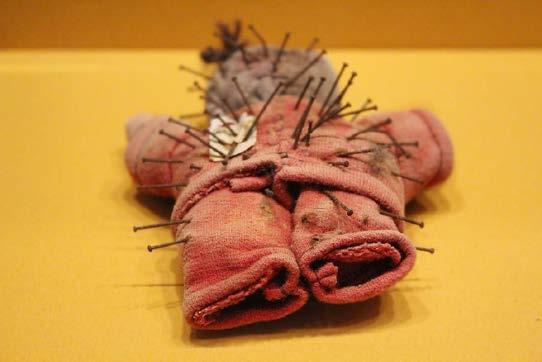
“You should put that back,” Ryan said quickly, then looked to Delia for reinforcement.
“Yes. Put it back,” Delia said, inching closer to Chad, trying to get a better look.
“No way!” Chad puffed his chest out. “This is too cool. Finders keepers.”
“This is cultural appropriation, literally.” Delia placed one hand on her hip, her other reaching to take it from him. “You are stealing a piece of culture for your own amusement, without thinking about—”
Chad cut her off. “I have to show this to Dave.” He pulled out his flip phone.
Madison rejoined the cabal in the street, looked at the doll, and asked, “Is that what I think it is?”
“Yep,” Ryan replied. “And he refuses to put it back.”
Madison stood in front of Chad and spoke calmly. “You need to put it back. It’s bad juju.”
Chad did not look up from his phone. “No way. This is going home with me. It’ll scare the shit out of Dave. He’ll be all like…” Chad mimics Munch’s The Scream, nearly poking his eye out with a pin.
Madison threw her garbage bag on the ground like a gauntlet. "Even if you don’t believe in bad juju, someone else does. Someone else wants it in that house. Enough to make a doll, then put it in a fucked up, abandoned house in the murder capital of the fucking country. Put it back where you found it. NOW!”
Madison stared hard until Chad met her gaze, then she pulled his phone out of his hand and jutted her chin up towards him.
“Now,” she seethed.
“Jeez, alright. It’s just a fucking doll,” he grumbled and pushed the doll towards Madison for her to return it. She recoiled.
“No, you bring it back exactly where you found it. If not, I’ll tell Coach Evans about this, and you’ll run laps for days.”
Chad grunted, turned around, and jogged up the stairs and through the door.
“Thanks, Madison,” Ryan smiled, raising his fist up for a knuckle dab, which she returned, her cheeks pink.
Delia stood in front of the house. She felt strange and hot. She’d never seen a real voodoo doll before, only the touristy gimmicks sold by fat goths in the Quarter. The urge to touch it, to examine how it was constructed, to feel its heft, coursed through her, barely contained by her skin.
The doll sat alone, in an empty house, waiting for the owners to work its magic. Or perhaps the doll prevented the owners from coming back. Not that she believed in curses. A devout atheist, Delia believed in science, not hocus pocus. She then winced at her ethnocentric dismissal of the doll’s power. Not cool, she admonished herself.
Later, on the way back to the rebuild center, Ryan and Madison chatted and cleaned while Chad sulked. When they passed the house with the doll again, Delia pretended to tie her shoe and noted the chipped paint was a salmon color, and the number 3 on the address hung upside down, precariously.
The nonprofit usually hosted a crawfish boil as a thank you for the volunteers. Half of the volunteers never made it, lured away by the city’s more titillating entertainment. Delia had become a pro at peeling the little buggers and teaching tourists how to suck the heads. She liked knowing how to eat them better than the taste.
Ryan spent the first thirty minutes helping Delia set up, then the next thirty talking to Madison. Delia, aware of Ryan’s waning interest in her, spent the rest of the evening laughing at his proto-dad jokes, occasionally pressing herself against him, rubbing his shoulders for a few minutes after he dumped the pot of hot, crimson crawfish onto the long fold-out tables.
Madison, forgotten, left early. During the post-party cleanup, Delia said she wasn’t feeling too hot, must have eaten a bad bug, and left Ryan safely tucked in her back pocket, just in case.
In her tiny shower, in the shotgun she shared with three other girls, Delia poured Dr. Brommer’s on her loofah and thought about the doll. She pictured it in her future home. A nice craftsman in a progressive city, she hadn’t decided which yet, Portland, Oakland, or maybe Pittsburgh. The doll would rest on her mantel by other artifacts from her future travels: a Tanzanian fertility statue, an ancient Chinese abacus, a tapestry above her fireplace given to her by an elder from a reservation, and the doll, slightly tattered, with the pin still in its back.
She would never point it out, but place it so worthy guests would gravitate towards it. Then she’d let her handsome husband, from a good family but with the right politics, and the good sense to pull her hair during sex, tell guests about Delia’s grueling volunteer experience in post-Katrina New Orleans before her admittance to Stanford law.
When her corn-fed nieces and nephews would visit their cool Aunt Delia and Uncle Whoever, they would whisper about Auntie D and the real New Orleans voodoo doll. Her siblings’ offspring would be tasked with keeping her legacy alive. Delia refused to join the horde of breeders. Her carbon footprint was enough for the world, especially with the many international trips she had planned.
She turned off the water, wiped herself down, and looked in the mirror. Her blonde hair, a few shades lighter from hours in the sun, dripped water on the cracked tile floor. Her farmer’s tan highlighted her biceps, developed from hours of labor. Her hours and hours of labor.
No one would miss it. The house was empty. And wasn’t she helping these people? They certainly did not pitch in while she cleaned their neighborhood. Sometimes they even watched and pointed out more things for her to do while they sat on their porches, drinking, waving fans, laughing. Not to mention that her stipend was a pittance. It was only fair. Recompense. Plus, wouldn’t she be helping whomever the doll was intended for? And didn’t Delia love helping people?
It was dark when she hopped on her bike and rode to the salmon house. She

decided not to tell Ryan; it’s not that he would chastise her, but he wouldn’t get it. Too much of an idealist, an ever-do-well, she thought. Unable to make the tough calls, to take what he wanted.
She parked her bike in front of the house, hoping it wouldn’t get stolen again. She’d already lost three bikes in the last six months. Delia then jogged up the stairs and pushed the creaky front door open. Using a keychain flashlight, she found the doll. It was facing the door, propped up in the corner of the barren room, as if it was expecting her. Delia grabbed the doll, placed it in a Rouses bag, and ran to her bike, pedaling like the Wicked Witch of the West through the jack-o-lantern streets.
Back home, she walked past one of her roommates, a crunchy Teach for America volunteer, to her tiny bedroom. She grabbed an empty shoebox from under her bureau and placed the doll in it face up. Delia stared at her prize, its eyes slightly off kilter, the four tiny holes in each button like eyes within eyes. She then turned it over and covered it with tissue and the lid. She slid it under her bed, worked on logic problems for the LSAT, and fell asleep. Delia slept peacefully, a dragon, content, above its hoard.
Delia replays yesterday’s heist in her head again and again as her feet hit pavement then mulch. This slows her down. She’s strayed from the path and stops briefly to take a breath. Somewhere in the arboretum, she figures, and the sun is nearly down. She was lost in thought again. Delia often complains about her inability to turn her mind off. Oh, to be like the halfwits blind to the daily injustices in the world. Fat and happy consumers of schlock. Turning off her music, she starts to backtrack the way she came.
Her eyes adjust to the darkness. She can just make out the shadowy outlines of trees, but there are no streetlights, only the grayish light emanating from her iPod. Delia, not immune to fear, recognizes her precarious position as a lone white jogger with her Apple product and vagina.
Sounds amplify: leaves rustling, insects buzzing, critters doing whatever it is critters do. She longs to drown out the cacophony with Ryan’s sad bastard music, but she knows that would be stupid. She’s tempted, though—to show she is not one of those scared white women.
“See,” her headphones would say, “I’m one of the cool ones.”
But she doesn’t feel cool right now. Every snapping twig is a threat. Sweat beads and falls down the back of her legs. Trees and brush flank her. An odor, an earthy, almost sulphuric scent, wafts in the air. She breathes through her mouth, but the smell intensifies so that she tastes it. In the tall grass, between the trees, a dark shape moves. A coyote? A dog? Another shadow appears. Three, now four shadows inside the brush between the oaks.
She’s had a few encounters with packs of wild dogs in her neighborhood. She knows what to do. Run with purpose, she tells herself, and tries to seem bigger. Running faster might trigger their need to chase, so she stomps steadily, whispering a cadence: alphabitch,alphabitch,alphabitch.
She throws a glance to her right. They form a line, just behind Delia. The dogs aren’t moving like dogs. The shadows must be distorting their bodies because their front ends seem much bigger than their back ends. The smell worsens, and she can hear them clearly. Not growling, but grunting, snorting, squealing.
Her pace quickens, so fast now that even Ryan couldn’t keep up. So fast that she stops thinking. So fast that she doesn’t see the gnarled root, her foot catching it, her ankle snapping.
Delia falls and cries, disbelieving. Eight eyes, dark like buttons, surround her— hungry, wild, authentic.

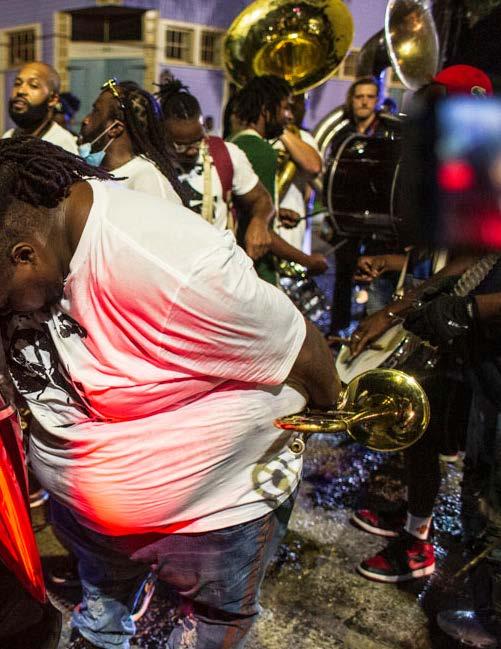 L.A. Reno
L.A. Reno

A few years ago, in the midst of the pandemic and a series of personal losses, I began a visual exploration of grief. After spending a summer fishing on a lake and studying Pieter Lastman’s painting JonahandtheWhale, I explored the many facets of grief through the metaphors of fish and water. In these culminating works of the series, I explore fullness that precedes loss, emptiness that follows, forged rifts in relationships, frantic attempts to reconnect, and the epic victory of surviving and emerging reborn.
Anglers is the prequel of my saga. It was one of the first paintings I started and the last I finished. The delay was partially due to some technical hurdles, but it seemed fitting because time and hindsight are critical elements in both art and grief. The inspiration is drawn from the initial fishing trip on the lake. The image represents the lush abundance that exists before a loss illuminated in hindsight. Two anglers set sail against a saturated sunset, casting their fine lines beneath the smooth surface. The scene is framed by tropical Louisiana foliage. I chose elephant ears, palmetto leaves, and palm fronds: hearty, plentiful plants that often grow out of control even in harsh conditions. These unruly plants line my own backyard, refusing to be contained and fighting off shears with spiny sheaths and toxic secretions. The still surface of the lake reflects the stone bridge and rows of palms, an idyllic scene with a magnificent beast lurking beneath the surface.
One of the technical issues early on was balancing the color. The water was a vibrant purple, chosen to complement the fluorescent yellow-greens in the foreground. It was so vibrant that it called to mind Lisa Frank’s nineties fever dream paintings of animals in rainbow biomes. While she was a childhood hero of mine, it was not the intended mood for this work. After months of staring at it in the corner of my studio, it became clear one day that I could tone it down while maintaining the richness by replacing the purple with dark blue. I played with various water levels and compositions before settling on what resembles a flat water line in a fish tank in the upper half of the canvas. The beast is contained and can be seen from a safe distance behind the billowing fronds. The anglers are specks on the horizon, great explorers in a beautiful vast world, unaware of what lies below, and perhaps trapped in a tank.
While Anglers depicts abundance, Lifeguard uses a sparse composition to convey emptiness. It explores the lens of a male partner as a couple navigates a loss. The image is formed by a compilation of outtakes from an underwater photography session, and the spontaneous nature of the images felt like the perfect opportunity for a snapshot of a family at a moment in time. The composition plays with space: the depth between the two figures, and the vast blue negative space surrounding them. The female appears in distress. Her distant figure is painted with broad strokes, and her face is clouded by large bubbles and the rough paddling of the dog. The dog is close to her, trying to save her but maybe pushing her further underwater. The male figure is shortened in the foreground, brightly lit with sharp details. Body hair is a focal point of the painting, serving as a suit of armor for the male, wrapping his head, face, and body. The hair is painted with thick, wavy, textured brush strokes, mimicking waves in water. His body is studded with crisp, effervescent bubbles. The hair and bubbles form an energetic charge within his figure juxtaposed with the still blue space surrounding him. His experience in the pool is very different from hers. He reaches for her but is unable to connect with her. There is a faint ladder in the distance suggesting a way out for both of them. The painting uses color to convey value with bright pink highlights and cool blue shadows.
 Lifeguard by Pam Skehan, 2022
Lifeguard by Pam Skehan, 2022
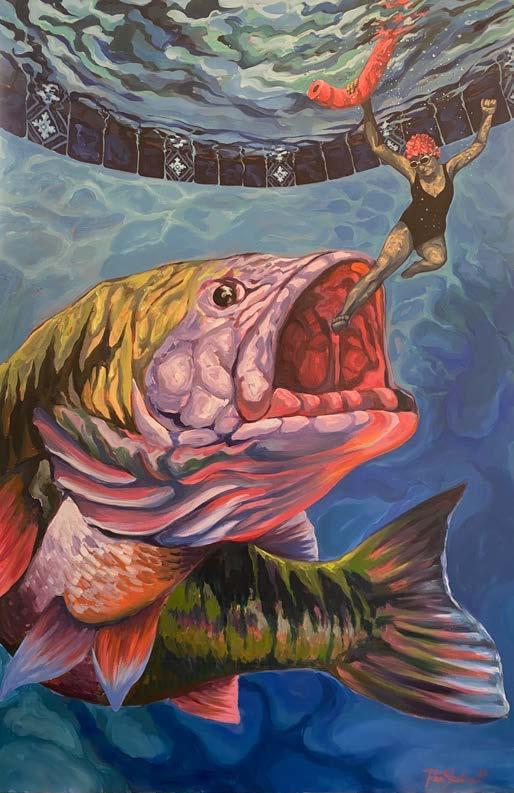
TheDeepEnd is the climax of the story, an epic battle between man and fish that demanded a monumental scale. It is the largest of the works at forty by seventy inches. The diver and the fish are placed in the same tank. Armed with a pool noodle, goggles, and a floral swim cap, the diver is ambiguously battling, floating, dangling, emerging or sinking. The figure vaguely strikes a gymnast’s final victory pose or a karate kick into the fish's mouth. The mighty fish dominates the composition with a sweeping arc, mouth gaping toward the diver. The deep end of a backyard pool represents a sterile microcosm. There is a sense of suburban sanitation. Disaster does not happen here. And yet, there is a giant fish in this pool. A sudden event can cause systems of security to crumble rapidly. Movement is a key element of this painting. The painterly brushstrokes in the water as well as the s-curve composition suggest a flow of energy. The perspective is from the bottom of the deep end, and the surface of the water distorts and transforms the tile patterns and the outside world. The water transitions from light blue to dark at the base of the pool, much like layers of the ocean. It’s unclear if the diver is winning or losing; the significance is that she is directly addressing it, swimming with it rather than against it. The fish and the figure have intensely saturated colors and textures, symbolizing how bright and beautiful the world looks after emerging from loss. Regardless of the outcome, this painting represents victory.
While this series of paintings is about a very personal experience, I hope to provide access through its universal themes. You might recall early memories of stepping to the edge of a pool and diving into the unknown, or treading water in a murky lake and feeling something slimy against your feet. In the years that passed since I began this series, bodies of water continued to beckon me: the lake, the river, the pool in my backyard. Somewhere along the line, as I gazed out at deep blue waves, watching a fish bob at the surface and a pelican dive below, dread was replaced with curiosity and horror shifted to awe and wonder.
ThisisthethirdandfinalinstallmentofThroughtheBellyoftheFish.Please seeBoothbyReviewVolumesIandIIforthefirsttwoinstallments.
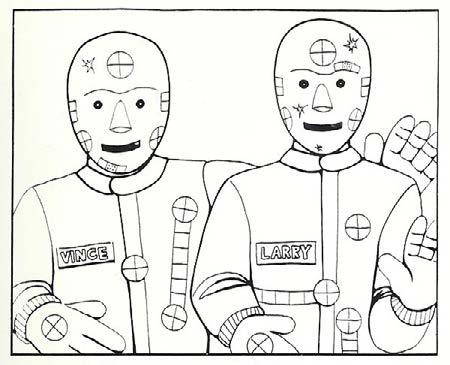
In 1637, the French polymath René Descartes iconically declared, in his treatise DiscourseontheMethodofRightlyConductingOne'sReasonandof SeekingTruthintheSciences, the statement that defines his legacy: “Jepense,donc jesuis,” or “I think, therefore I am.” The line, which Descartes would later render in Latin as “Cogito,ergosum”—and even later as “Dubito,ergosum,vel,quodidem est,cogito,ergosum” (“I doubt, therefore I am, or, which is the same thing, I think, therefore I am”)—comes in a discussion of what’s become known as the mind-body problem.
Full disclosure, though, before we go further: I have never taken a philosophy class, despite having earned three liberal arts degrees, two of them advanced. (Liberal arts degrees—collect them all!) I also confess I haven’t read much philosophy beyond Plato’s “Allegory of the Cave” and sections of Aristotle’s Poetics. Some years back, I did read most of PlatoandaPlatypusWalkintoa Bar...:UnderstandingPhilosophyThroughJokes (Cathcart & Klein 2007); but I’m not sure that’s relevant here. So, grant me some grace if I fall short of a cogent, comprehensive, or even accurate explanation.
As I understand it, the mind-body problem is the question of whether we are material and finite, as the corporeal body would seem to suggest, or whether we are immaterial and infinite, as the conscious, subconscious, and perhaps even unconscious mind would seem to suggest. Descartes felt that his physical body was proof of his existence, but that his thinking mind was his essence. Yet, the fact that he thought and questioned his existence was also proof of that existence. (“I think, therefore I am.”) While these material and immaterial states are distinct and exist independently, what’s key is that they interact; and each has a causal influence on the other. And that, my friends, is Cartesian dualism. Five cents, please.
So I thought it would be fun to rank and critique ten classical or contemporary dualities according to my own subjective criteria. (Doesn’t that sound like fun? It did to me when I was sitting up late one night watching Midsomer Murders and Vera on Britbox and puzzling over what to write.) I’m sure there are myriad other examples of dualities, and I have no doubt there are better ways to differentiate them; but my list, my rules. Please send any and all critiques to the Editor-in-Chief of this illustrious publication, as he simply loves responding to grousing emails. Nunc: cogito,ergojudico! (Now: I think, therefore I judge! Five years of Latin, baby!)
Racial connotations aside, “Black and White” is a classic example of forces in opposition; but it’s more a dichotomy than a duality. There is no real give-andtake between the two; as concepts, we depend on each being distinct from the other. We want black and white to be binary, to give us clear-cut lines. Without that distinction, they don’t so much influence each other as blend into each other. We get compromise. We get nuance. We get gray. Or do we? See, we have to qualify what we mean when we say “black” and “white.” For example, in additive color mixing, or the mixing of light, black is the absence of color, and white is the sum of all colors; whereas in subtractive color mixing, or the mixing of pigments and materials, white is the absence of color, and black is the sum of all colors. They can mean the same thing or opposite things depending on context. As George Orwell wrote in Nineteen Eighty-Four,
The keyword here is BLACKWHITE...[and] this word has two mutually contradictory meanings. Applied to an opponent, it means the habit of impudently claiming that black is white, in contradiction of the plain facts. Applied to a Party member, it means a loyal willingness to say that black is white when Party discipline demands this. But it means also the ability to BELIEVE that black is white, and more, to KNOW that black is white, and to forget that one has ever believed the contrary. Boy, it’s a good thing that we’ve never had to experience that particular dystopian nightmare, isn’t it? Whew!




The problem with Heaven and Hell is that none of us know exactly what they are or might be. Sure, we have ideas. Certain religious texts offer descriptions— heaven is usually a kind of everlasting paradise, whereas hell is eternal torment— but not every religion teaches these polar-opposite afterlives. And while desire for heaven or fear of hell might lead people to make better choices in life, heaven and hell don’t have much apparent influence over each other, making their relationship more dichotomous than dualistic. That said, the tension between the two extremes is frequently explored in art, such as in Hieronymus Bosch’s TheGardenofEarthly Delights, where elements of the two seem to coexist. (If you’ve never seen The GardenofEarthlyDelights, you should check it out. It’s like a filthy, demented Where’s Waldo from the 1500s.) We also see examples in theatre and literature. William Shakespeare gives us a great one in HenryVI,PartIII, when the devious Duke of Gloucester [spoiler alert!] kills his cousin, King Henry VI, swearing, “Then, since the heavens have shaped my body so, / Let hell make crook'd my mind to answer it.” In a subsequent play, and in almost Cartesian fashion, Gloucester’s “heavenly” material body and “hellish” immaterial mind do interact to make him into the divinely villainous Richard III.
The Swiss psychologist and psychoanalyst Carl Jung, in his 1933 essay collection Modern Man in Search of a Soul, wrote, “Every good quality has its bad side, and nothing that is good can come into the world without directly producing a corresponding evil. This is a painful fact.” Jung doesn’t say whether evil can come into the world without directly producing a corresponding good; but that wasn’t his point. Jung felt that, in order to be truly good, people needed to accept their capacity for evil and keep it under control. When our capacities for “good” and “evil” are in balance, then we can achieve a kind of harmony. But in order to balance those forces, we have to confront the evil within ourselves, which Jung called the “embodiment of the monster” or “the shadow.” The thing about Good and Evil, the catch that keeps their duality from ranking higher on this list, is that Good and Evil themselves are conceptually nebulous, and not just within the upside-down of our own posttruth, hyper-politicized society. Concepts that are generally accepted as good can be painted as evil by those who don’t feel their interests are served; and even the extreme evil of genocide can be justified as “good” by the people leading it. (See #10 “Black and White.")


If justice is absolute adherence to the letter of the law, then mercy is a deference to the spirit of the law. When we consider the implications of a law, determine reasonable exceptions, and allow for empathy and understanding, we are exercising mercy in judgment; but some feel that the application of mercy weakens or perverts justice. Shakespeare, that wonderful observer of human nature, gives us a true lesson in the interaction between justice and mercy in The Merchant of Venice. The merchant Antonio borrows money from the moneylender Shylock. The terms of the loan are clear: If Antonio fails to repay the loan on time, Shylock may extract a pound of Antonio’s flesh. Portia, a wealthy heiress and friend of Antonio, pleads in court on Antonio’s behalf, delivering one of the Bard’s most famous speeches, “The quality of mercy is not strained.” In the speech, Portia posits that power is worldly, but mercy is divine. “And earthly power doth then show likest God's / When mercy seasons justice.” But Shylock (spoiler alert, again!) refuses mercy; he wants his pound of flesh, dammit. Portia then reverses course and adheres to the absolute letter of the law, which ensures the penalty of the pound of flesh but makes no mention of blood. Therefore, Shylock may take only flesh and not blood, which would be impossible. Shylock, by refusing to allow justice to be influenced by mercy, finds himself undone by that same merciless justice.
The meaning of “chaos” can get pretty warped depending on context. (I'm looking at you, Physics. You, too, Math.) In most common usage, it’s taken to mean “disorder.” If the opposite of “disorder” is “order,” then we find ourselves with another simple dichotomy. But the relationship between chaos and order is more complex than that. Regardless of the order we as humans impose on a given system or situation, chaos will always have an influence and will eventually win. Neuroscientist Abhijit Naskar, in InganImpossible:HandbookofHatebusting (2022), describes order as “nothing but a friendship with chaos.” We can also shift perspective and see chaos not as disorder but as infinite potential. Theatre director Peter Brook, in his revolutionary 1968 work TheEmptySpace, theorizes, “I can take any empty space and call it a bare stage. A man walks across this empty space whilst someone else is watching him, and this is all that is needed for an act of theatre to be engaged.” The limitless possibility of the empty space is transformed by order: an action, an actor, an audience. We can say the same of any blank canvas transformed by an artist’s strokes, of a blank page (or screen) transformed by the writer’s words, or of silence transformed by the musician’s notes. The intersection of order and chaos is the place where art is born. (Take that, Physics. You, too, Math.)


Albert Einstein, perhaps the greatest thinker of the 20th century, famously stated: “The more I learn, the more I realize I do not know.” This paradox is the crux of intellectual curiosity, the motivation for the continual pursuit of knowledge. Similar to Jung’s contention that we must acknowledge our capacity for evil in order to be good, the quest for knowledge begins only when we admit ignorance. Our prior knowledge reveals to us those areas where we are ignorant, and our persistent ignorance shapes the ways in which we acquire new knowledge. As it is impossible to know everything, though, our ignorance will always outweigh our knowledge. Former U.S. Secretary of Defense Donald Rumsfeld put it eloquently when he said in 2002, “...there are known knowns; there are things we know we know. We also know there are known unknowns; that is to say we know there are some things we do not know. But there are also unknown unknowns—the ones we don't know we don't know.” And you know, the things you don’t know you don’t know are the ones that will get you. [Bonus Nerdy Factoid: Rumsfeld didn’t coin “unknown unknowns.” That honor goes to psychologists Joseph Luft and Harrington Ingham, who in 1955 developed the Johari Window, a tool for increasing self-awareness and identifying one’s conscious and unconscious biases.]
In art, the term chiaroscuro, literally “light-dark,” refers to the balance of light and dark tones to give a two-dimensional image a shading that appears threedimensional and thus more lifelike. The light and dark tones are equally important to the process, and their interplay is what makes the effect work. Chiaroscuro came to prominence in the Renaissance and is a cornerstone of the Baroque period. Similar balancing of light and dark can also be seen in photography and film, where the two-dimensional frequently takes on a three-dimensional aspect; and in the theatre, where space can be shaped and manipulated by the interplay of light and darkness. Light and darkness are on a continuum rather than in opposition, and each always has an influence on the other. Some darkness, such as shadow, cannot exist without light to create it, and some light, such as a single candle, can seem so much brighter depending on the darkness that surrounds it. Each is defined by the other, and as Walt Whitman wrote in his 1856 poem “Miracles”: “To me, each hour of light and dark is a miracle.”
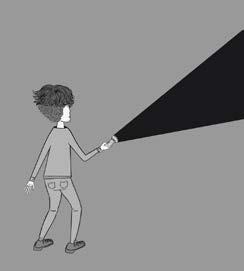

Wait, didn’t we just do “Light and Darkness”? Isn’t this the same thing? Well, no. The measure of day or night is in constant flux, dependent on the rising and setting of the sun over the horizon. That measure is also dependent on one’s physical location in the world, with those at or near the Equator experiencing roughly equal hours of day and night throughout the year, and those at or near the North Pole and South Pole experiencing periods where daylight or night can last for more than 24 hours. What we call “day” changes with circumstance: It could mean when the sun rises, or when we wake, or the time between our waking and sleeping on a specific date regardless of whether the sun is out. “Night” could start after work, or as soon as we get home, or when we meet for dinner; and it can maintain its hold until the next day’s dawn, well after its own calendar date ends. Consider, too, the murky, mystical twilights of dawn and dusk, those liminal spaces of day and night, when we are in either, both, and neither all at once. When we dare to manipulate the natural flow of day and night, though, madness results. Consider the invasive imposition of Daylight Saving Time. Although time is relative, the shifting of an hour from Standard Time (or “The One True Time”) to Daylight Savings Time (a.k.a. “Fake Time”) results in widespread circadian misalignment, increases in adverse health outcomes, and a rise in traffic accidents. “But it gets dark so early in the winter.” Well, yeah. That’s the way it works. “But it’s so nice to have the sun in the evening.” No. You try getting an eight-year-old to go to bed while it’s still daylight outside. I will die on this hill. We mess with day and night at our peril. People who love their long, sunny summer nights won’t listen to reason, and as Polonius says in Hamlet, to debate “why day is day, night night, and time is time / Were nothing but to waste night, day, and time.” #standardtime4ever
The moment we’re born, we begin our inexorable slide toward death. As John Kander and Fred Ebb wrote in their 1968 musical Zorba, “Life is what you do while you’re waiting to die.” (In another of their musicals, they also wrote that “Life is a cabaret,” so you do have options.) Life and death are inextricably entwined, and each does indeed influence the other. The looming spectre of death might inspire one to lead a more considered life, and the way one lives could either hasten or forestall one’s inevitable death. We want a strong mind (and spirit) in a healthy body for as long as possible, but we know it won’t be forever. And, as with the above assessment of Heaven and Hell, we have to consider that there is something beyond this life that we do not know. We assume that death is the end punctuation on the sentence of life, but could it be a different sentence all its own? We don’t know, and that mystery is part of the reason we often fear death. Shakespeare’s Hamlet called it “the dread of something after death- / The undiscover'd country, from whose bourn / No traveller returns.” Could it be another plane of existence, parallel to this one, or do we just... stop? Are near-death experiences really a glimpse of what lies beyond, or are they merely the result of random electrical brain activity? Are what we call “ghosts” just curious coincidences, or are they a real attempt by the dead to communicate with the living? We don’t always understand supernatural phenomena, and we often want to explain them away in terms that we can understand. But we do need to reckon with the possibility that death may have more of an influence on life than we care to admit. (Because ghosts are real, right? We all agree on that, right? Right?)


Mel Brooks, one of the greatest comic minds of the past hundred years, explained the dualism of comedy and tragedy this way: “Tragedy is when I cut my finger. Comedy is when you fall into an open sewer and die.” We tend to magnify the little things that happen to us; we’re too close to them, we’re aware of the biggest impacts of the smallest slights. We have no distance, no perspective. Now, Brooks exaggerates the alternative for comic effect; we wouldn’t really laugh at someone who falls into an open sewer and dies, would we? (I mean, not unless the timing was impeccable.) But we do have the emotional and intellectual detachment to put the experiences of others into context, something we can’t often do for ourselves. To put it another way, the influential filmmaker Charlie Chaplin once noted, “Life is a tragedy when seen in closeup, but a comedy in longshot.” Chaplin also wrote in his 1916 autobiography CharlieChaplin’sOwnStory: “Whether it is tragedy or comedy depends on how you look at it. There is not a hair’s breadth between them.” Of course, it’s not just how we look at it; it’s also how we process it as evidenced by the observation, attributed variously to Horace Walpole, Jean Racine, and even F. Scott Fitzgerald, that “the world is a comedy to those who think, a tragedy to those who feel.” Thinking lets us step back and view situations in abstract, whereas feeling and empathy align us with the victims of those circumstances. In theatre and literature, comedy gets us to think about absurdities and incongruities in the world around us. Tragedy, on the other hand, gives us a chance to experience misfortune vicariously— the characters go through hell so that you don’t have to—leading us toward catharsis, the releasing and relieving of all our pent-up emotions. Thinking and feeling motivate physical reactions, such as laughter, tears, or action, proving that comedy and tragedy engage both our immaterial minds and our material bodies, the very essence of Cartesian duality. Q.E.D. Mic drop. Curtain.


Francis Bacon, the impresario of the Scientific Revolution, proclaimed humankind’s dominion over nature as the object of the new science. Isiah Berlin later clarified that particular worldview with a precept: “Nature, I can, at least in principle, always mold by technical means, and shape to my will.” Ancient Greeks in their dramas, myths, and histories called this hubris, an excessive pride that blinds one to pitfalls and potential failings. Hubris is a recurring theme in science fiction, most notably in Mary Shelly’s Frankenstein and Stanley Kubrick’s 2001ASpaceOdyssey. Hence, AI can only give us pause.
This raises a question about The Mysteries by Bill Watterson and John Kascht — is this yet another cautionary tale about humanity doing itself in by folly and arrogance? Perhaps. The story begins in a medieval setting with peasants terrified of mysteries lurking in dark forests and misty bogs. The king dispatches knights to capture the mysteries, and once one is found the
people realize the power of knowledge to expose the mysteries as prosaic if not overrated. Enlightenment thinking ushers in the modern, the forests are cut down, the bogs drained, and technology liberates humanity. Yet once confidence to understand all things sets in (i.e., hubris), the universe changes and things start to happen beyond human comprehension. The mysteries remain.
One is tempted to make this into an allegory of climate change. But that’s too easy of a fit. By design The Mysteries belies facile explanation. The prose is all of 400 words, and Mr. Kascht’s illustrations at first glance have a medieval puppetry thing going, like creepy characters in a Mr. Rogers fairy tale. But it works. The psychological effect of the pictures (term that is used) on the reader elevates the prose and vice-versa. Mr. Watterson of Calvin and Hobbes fame, and Mr. Kascht, a caricaturist of the rich and famous, each had veto power over the other, which is why it
took so long to finish the work and why the storyline effectively balances admonishment with the ineffable. Like a good fable.
I don’t know if either Mr. Watterson or Mr. Kascht are Catholic, but the engagement with mystery seems reminiscent of 20th century Catholic writers like Graham Greene, Flannery O’Connor, and Walker Percy. A Jesuit friend, now departed, called it the Catholic imagination. Medieval people who built the great Gothic cathedrals held the mysteries in awe. While the Enlightenment attack on superstition was well founded, circumspection and humility are always in order. TheMysteries reminds us that the more we know, the more is revealed of what we don’t know.

If you haven't read the biographies written by Anderson Cooper, but you enjoy his style of reporting from all over the globe, you may enjoy his books. Cooper began his solo reporting career in the early '90s, traveling the globe, living amongst chaos and the dangers of global communities. While submitting his stories and observations of political turmoil, he eventually landed a job with Channel One and later ABC's World News Now. Some may know him from CBS News or 60 Minutes.
You may choose to read Dispatches fromtheEdge, a memoir of his travels to report on war and natural disasters, or the deeply personal The Rainbow Comes and Goes: A Mother and SononLife,Love,andLoss. This is an interview with his mother that is replete with brutal candidness and
honesty about his own obstacles in life and relationships: how they were influenced by the loss of his brother, his famous mother's successes professionally, and her personal challenges in love and loss.
Here is the list:
~Vanderbilt: The Rise and Fall of an AmericanDynasty
~The Rainbow Comes and Goes: A MotherandSononLife,Love,and Loss
~Astor: The Rise and Fall of an American Fortune
~DispatchesfromtheEdge:A MemoirofWar,Disasters,and Survival
~The World of Gloria Vanderbilt
The Bomber
In short: Fat Man and Little Boy get all the attention. These two atomic bombs killed an estimated 100,000 in Hiroshima and Nagasaki. However, Malcom Gladwell argues that other bombings, in that same country, were far more impactful. The Bomber Mafia focuses on the firebombings of Japanese cities which killed upwards of 1,000,000 people. He explores the ethical choices made by American generals in 1942. Should U.S. bombers focus on high-value military targets such as bases and factories? Or should we morale bomb, also called terror bombing, like our British counterparts and attack civilian targets without military value, in the hope of completely demoralizing the enemy? Are more civilian casualties worth it if it ends the war sooner? Read, and draw your own conclusions!
Reactions to Maestro, Bradley Cooper’s biopic of Leonard Bernstein, at least in my limited circle, have been negative, even hostile. There is even enmity toward Maestro by people who have not seen the film. National reviews have been more forgiving about Mr. Cooper’s prodigious effort, but there is the caveat that it hardly celebrates Bernstein’s work. For example, WestSideStory is barely mentioned and unless I missed it, there is nothing about his opera, Candide, a major work in the Bernstein repertoire. Instead, the focus of the film is on Bernstein’s relationship with his wife, Felicia Montealgre, played brilliantly by Carey Mulligan.
Bernstein was the stuff of legend. Before him conductors of major philharmonic orchestras were European: Bruno Walter of the New York Philharmonic hailed from Germany, Serge Koussevitzky of the Boston Symphony from Russia, Leopold Stokowski of the Philadelphia Symphony from Great Britain (though he played up his Polish origins), Fritz
Reiner of The Chicago Symphony Orchestra was a Hungarian émigré, and Pierre Monteux of the San Francisco Symphony, a French native. The beginning of Maestro has 24-year-old assistant conductor Bernstein awakened with a phone call on November 14, 1943. After lighting a cigarette, he is told that Bruno Walter has taken ill. Bernstein has to mount the podium for the afternoon concert at Carnegie Hall with no rehearsal yet acquits himself brilliantly and becomes a household name. Later his genius is recognized as a composer in musical theatre, opera, and classical works. He was what Isiah Berlin called a fox, an intellectual “seizing upon the essence of a vast variety of experiences and objects for what they are in themselves,” as opposed to a hedgehog “who relates everything to a single vision” like a Plato or Marx. Bernstein defied categories or boxes.
But he could also be a meretricious bore as well as a narcissist, and Cooper pulls no punches. That Bernstein loved promiscuously both men and women led to human
wreckage, most notably in his family. Discretion was beyond his grasp, and his actions had an exhibitionist quality even before social media. For example, in the film when he gives a pedantic talk to a rehearsal audience about the essence of music being human freedom, it is actually a facile rationalization for his leaving Felicia to live with his lover, Tom Cothren. While he returns to Felicia (in real life losing his family was too much to bear), Cooper leaves open the question of redemption. But the culminating moment of the film, when he runs to her offstage after conducting Mahler’s Second Symphony, leaves no doubt that there was legitimate love. When Felicia succumbs to cancer, Bernstein is not only bereft but blames himself for her death.
The film does justice to one of Bernstein’s great passions, teaching. His Young People’s Concerts, televised on Sunday afternoons, his Harvard lecture series, and the PBS interviews on Beethoven were all about bringing classical music to the public. Growing
up when I did, it was impossible to separate Bernstein from classical music because he was classical music. Anyone else was just a poser. His transcendent joy came from teaching young aspiring conductors and musicians in summers at Tanglewood in the Massachusetts Berkshires.
Perhaps the film can disturb because a relationship with Bernstein could be both exhilarating and crushing. Felicia knew she was marrying a man who was primarily homosexual, but the humiliations endured hardly seemed worth it. Nevertheless, Cooper deftly plays a man who desperately loves his wife in spite of it all. And Felicia refuses to play the victim in spite of it all. It was a complicated, difficult, but interesting union. We have all been there in some form with another, and Maestro is a stark reminder that human relationships are what drives us for good and ill.
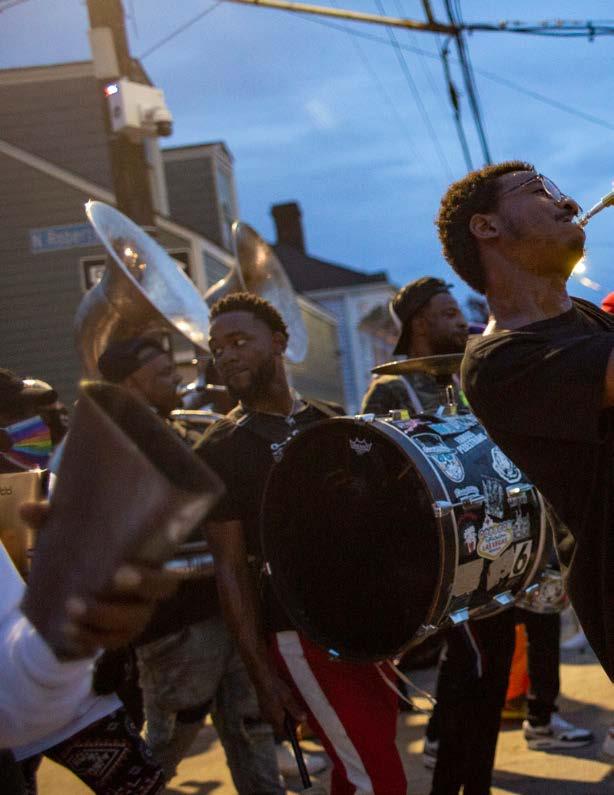
 L.A. Reno
L.A. Reno
This now-legendary questionnaire was inspired by French writer Marcel Proust, and for our third volume TheBoothbyReview sat down with Katie Antis. Katie is the Arts Department chair, the director of instrumental music for 3rd-12th grade, and she can play every instrument in the orchestra.
What is your idea of perfect happiness? Myideaofperfecthappinessisastatewhere onecanexperiencewonderandawe.Therearesomanybigandlittlemomentsin mylifewhenIfeelluckyjusttohaveexperiencedit,whetherit’sabeautifulsunset, holdingthehandofalovedone,athought-provokingnovel,arandomactof kindnessbyastranger,oranamazingperformancebyasuperstar.
What is your greatest fear? Mysuperficialfearisdarkwater:waterthatIcannotsee tothebottomof(darklakes,ponds,bayous).Iwillonlygetinthewaterifitiscrystal clearandIcanseeeverythingelsethatisinthewaterwithme. Myrealfearistragedy.IrecognizethatIhavelivedanabsolutelycharmedlifewith norealhardshipsorchallenges.Sure,I’veworkedhardforwhatIhaveachieved andI’veexperiencedsadordifficultthingsbutnotatruepersonaltragedy.Atrue tragedymightjustbreakme.
What is the trait you most deplore in yourself? Procrastination.
What is the trait you most deplore in others? Meanness.Just,why?Whyspend energybeingmeanandexclusionary?
Which living person do you most admire? Yo-YoMa.Heisjustagemofahuman being.Heissincerelykind,generous,opentoallkindsofcollaboration,andan immenselytalentedmusician.Ihavebeenluckyenoughtoseehimperformlivejust aboutamonthago,butonceIhappenedtolive-streamaperformanceofhisinthe NationalCathedralwhereheplayedallthemovementsofallsixBachsuites.Itwas overtwohoursofsolocellomusic,andheperformeditallfrommemory!Ofcourse, hisperformancewasexquisiteandnearlyflawless,buthedidhaveafewmistakes,
suchaswhenhisendpinslippedonthe stone floor. Proof that he is a human beingafterall!Afterthismomentousand inspiringperformance,theaudiencegave himawell-deservedstandingovation,but hestoppedthemafterabout20seconds toinvitetheHowardUniversityGospel Choironstagetoperformanencorewith him!Hethengraciouslyacknowledged themoverhisownperformance.Whata wonderfulexampleofgenerosity.
What is your current state of mind?
Wonder and awe with a side of stressed out.

What do you consider the most overrated virtue? “Hardworking.”Idefinitelyascribe to the axiom “work smarter not harder.” Ilovemyjob,andIamverygoodatit.Iworkhardatmyjob.Iknowthatthereare certainseasonsthatarebusierthanothers,suchasthedaysandweeksleadingupto aperformance,butIalsoknowthatthereisanebbandflowwiththesebusyseasons.
What do you most dislike about your appearance? Ihavefinallyreachedtheagethat Idon’thaveanythingIdislikeaboutmyappearance,butIamprettyoffendedbythe conditionofmylowerbackanditsunwillingnesstocooperate.
What is the quality you most like in a man? Kindnessandsensitivity.Iwanttobe friendswithamanwhocangetpastsociety’sexpectationsofmanlinessandshow kindness,sensitivity,andconsiderationofothers.Luckily,Ihavemanymenlikethis inmylife.
What is the quality you most like in a woman?
Curiosity.Ihavenopatienceforajadedwomanwhoactslikesheisnotimpressed andcannotfindanythinginterestingtoconsider.Thisisanamazingworldwith amazingpeople,andwegettoexperienceit!Thereisalotofworktobedone,for sure,butlifehereiscertainlynotboring,sodon’tactlikeit.
Which words or phrases do you most overuse? Notawordorphrase,butIoveruse theexclamationpoint!!!
What or who is the greatest love of your life? Unsurprisingly,musicismygreatest love,butmyfamilyistiedforsecond.Beingabletomakemusicwithmyfamilyis theperfectcombinationofmyloves.Ihavebeenluckyenoughtohaveperformed withmyfather,mother,sister,brother,husband,andsons.Therearenowordsto describetheconnectionwefeelwhenwegettomakemusictogether,butoneof mysonscameclosewhenhedescribeditas“feelinglikeyouwanttocry,butnot becauseyou’resad.”It’sjustthatoverwhelmingemotionofhumanitythattellsus that we are connected.
When and where were you happiest?
Ihavehadalotofreallyhappymomentsinmylife,andIthinkitisbecauseItry toreallyappreciatebigandlittlemomentseveryday.Obviously,Ihavehadmany, manyhappymusicalmoments,bothasaperformer,aconductor,andanaudience member.I’vebeenluckyenoughtoperformatCarnegieHall,toconductthe LouisianaPhilharmonicOrchestra,tosinganddanceatDisneyWorld,andtoshare manystageswithmyfamily.Ialsorememberbeingveryhappyjustplayingboard gameswithfriends.Ihaveaveryspecificmemoryofbeingwithmyhusbandon SpringBreakseveralyearsagowhentheweatherwasjustperfect-nottoohot,not toocold,andnoimmediateresponsibilities.Talkaboutperfection!Finally,myheart justaboutburstsoutofmychestwithpridewhenIwatchmychildrendothethings theylove.

Which talent would you most like to have? Iammoderatelycoordinated,butI wouldlovetobeabletoreallydancewith confidence.Ballet,tap,jazz,swing,hip hop,anything!
If you were to die and come back as a person or a thing, what would it be? A cat. Orabutterfly.ACatterfly.Iliketaking napsandbeautifultransformations.
What is your most treasured possession? Idon’treallyvaluealotofmyphysical possessions.HurricaneKatrinataughtmethatphysicalpossessionscancomeand go,butyourrelationshipswithotherhumanbeingscannotbereplaced.Intermsof somethingphysicalthatIown,IguessI’dhavetosaymyweddingring.It’sasimple, thin,goldband,butitmeansalot.Andit’sbeenthroughalot!Itiscurrentlyan ovalshapebecauseadoorslammedonit.(Thefacultycenterdoor,tobeexact.)My fingerswouldhavebeencrushedifnotforthatsimple,thin,goldband.
What do you regard as the lowest depth of misery? Notbeingabletofeel.Likefeel anything.EvenfeelingsadremindsmethatIamhuman.
What is your favorite occupation? Teacher-mom.Theyaresointertwinedandbleed intoeachother.Beingateacherhasmademeabettermomandbeingamomhas made me a better teacher. I love both!
What is your most marked characteristic? Mycheerfulness.I’msureit’sannoying toothers,butIgenuinelyamhappymostofthetime.WhenIamupsetorangry,I usuallyfindawaytoworkthroughitprettyquickly.
What do you most value in your friends? Ivaluefriendswhoareunpretentious. Evenifwe’redoingsomethingfancy,let’sjustenjoyitandnottakeourselvestoo seriously!
What is it that you most dislike? Time-wasters.Bothpeopleandthings.
What is your greatest regret? Ihaven’tsungenough,andIdon’tdanceenough.
How would you like to die? Ataveryoldage,peacefullyandinmysleep.
What is your motto?“Earlyisontime.”Butnotabouttheendofmylife.Earlyis NOT on time in that case!
Click anywhere on the crossword to print. Enjoy over a favorite beverage or dessert. Solution (should you need it) on p. 125.
ACROSS
1 "Me, too!"
5 Fr. ladies
9 Sp. ladies
13 Awards stage
17 Reveals
18 John of the Velvet Undeground
19 "What _____ I say?"
20 Killer whales
22 Assumed name
23 Enigmas (as opposed to 114A)
25 New Orleans neighborhood
26 Oddsmaker's last words?
27 Tilted
28 Narrow channel
29 First responders, initially
30 Old-school soda brand
32 Old German?
33 Squeeze (out)
34 Miracle-___
35 Appear
37 Thalia's purview (as opposed to 87A)
39 Director of Lawrence of Arabia
42 Jobim hit "The Girl from ________"
44 Indigence (as opposed to 95A)
45 Body doubler?
48 Everlasting, poetically
50 Obscure 1877 play by Mark Twain and Bret Harte
53 Gives temporarily
55 Makeover
56 "It was a _________ while it lasted."
59 Ripen
60 The third blonde roommate on Three's Company
62 Continual misfortune (as opposed to 70A)
64 Mop
66 The little foxes?
68 Very wide shoe designation
69 Not Europe or the Americas (as opposed to 95D)
70 Whimsical good fortune (as opposed to 62A)
74 Last writes?
77 UFC combat style
78 Fertilizer found in caves
79 Whitaker's Oscar-winning role
81 Winner of 2023 Emmy for Best Comedy
83 O'Hara's Butler
84 Colts head coach 2012-2017
86 Tennis legend Goolagong
87 Melpomene's purview (as opposed to 37A)
89 Like winter windows or cereal flakes
92 Hire for a Cuban wedding, maybe
95 Prosperity (as opposed to 44A)
96 LIttle barks
100 Citation style
101 Fill-in
102 Summers in Paris
104 Shoe widths a step down from 68A
106 When doubled, the yellow Teletubby
107 Measures twice, cuts twice?
109 Over-the-shoulder support?
111 Scrabble letters
113 Theatre pathway
114 Answers (in opposition to 23A)
115 Parks et al.
116 Cast aspersions
117 Extraordinary thing
118 Prefix meaning "billionth"
119 Cynewulf poem
120 Heroic exploit
121 Cellist Ma
122 FBI agent
123 Fur babies
1 Biblical dancer who got a head?
2 Melodious
3 Average
4 Eat in Munich?
5 Carson's Ed
6 1937 Jeanette MacDonald-Nelson Eddy movie musical
7 "Frozen" princess
8 Schedules, as the newly affianced
9 Sabre-toothed squirrel in 15D
10 Spoiled someone's parade, perhaps
11 "Look, how a bird lies tangled in _____" (Shakespeare's Venus and Adonis)
12 Bro's sib?
13 Attended to a specific detail?
14 Pirates think, therefore they _____!
15 2002 animated film set in the Pleistocene epoch
16 Emmy-winner Wiley
17 Hitchcock's notorious motel
21 First American saint
24 ____ May Clampett of '60s TV
28 It's likely atop an Aspen-bound Subaru
31 Old French trick-taking game
33 First lady
36 Thinking self (as opposed to 62D)
38 Collective title for retired professors
40 Alphabet City thoroughfare
41 Essential amino acid
43 Annoyance
44 Susceptible (to)
45 Felony designation
46 Tights, socks, and hose
47 Terrestrial
49 End of a college URL
51 Creative guys
52 Nebbishy Les of WKRP in Cincinnati
54 Exterminator giant
57 Treatment advice for a sprain
58 To assist in Latin?
61 Unwrap
63 Tragic Verdi heroine
65 Sires
67 Overly theatrical
71 Aspartame brand name
72 Framework for managing and distributing digital information
73 Singer Sumac
75 "This Is the Day" band
76 Late golf great Ballesteros
80 Plaguing
82 Physical self (as opposed to 36D)
85 Cannonball of jazz
88 Some have the gift of it
90 Mamet two-hander
91 Spouse's boy
92 Lee and Teasdale
93 Crypto-slang for investing without research
94 TV title role played by six different actors over 17 seasons
95 Not Asia or the Levant (as opposed to 69A)
97 Good to go
98 Encomia
99 Former Nebraska senator Ben
103 Bullish start?
105 Amoxicillin target
108 Mont Blanc milieu
109 Pro follower?
110 Meander
112 Princess abducted by Hercules
114 Vegetal milk option
Angela Beerman continues to explore and expand her roles of mother and daughter, while memory becomes the haven and challenge to reach her aging mother’s heart. Pivoting to a new role as Go Go (grandma) and mother of a daughter with a new son, stretching and enriching the heart and mind, always surprising and full of joyful, unimaginable discovery.
Sam Ferguson is not yet a novelist, but he is at work on a novel.
In past issues of TheBoothbyReview, Justin Gricus has attempted to present himself as sophisticated and complex by writing about the music of Bob Dylan and the origins of the Mississippi Hill Country Blues, but in reality, his life is rarely more puzzling than a Neil Diamond song.
Robin Heindselman is a person of simple tastes who is impossible to please. At home she dreams of traveling, and while traveling she dreams of chilling with her cats. She was about to say that our inability to be two people at once is a design flaw, but then she remembered her college boyfriend. She is an insomniac living in New Orleans.
Jason Hubert came from Boston to the South. He's a Lobstah amongst crawfish. A Panthers fan amongst Saints. A Gator amongst tigers. A skier living in the swamp...And yet, he never wants to leave.
Howard Hunter's quest for aesthetic transcendence is constantly being debauched by modern life. His sybaritic tendencies render his chances dim at best. But hope springs…
A true product of Country Day, Jennifer LaCorte Marsiglia is both left- and right-brained and sometimes feels neither left nor right, right?
Mike Miley craves the spotlight but likes being left alone, hates television shows but loves Twin Peaks, adores movie musicals but could do without musical theater, loathes contemporary pop but is also really fascinated by Lana Del Rey, and can’t stand playing sports but lives for disc golf. Kris Kristofferson would call him a walking contradiction, but Walt Whitman would go easier on him and say he contains multitudes.
Sean Patterson hates writing bios and talking about himself, but he loves quoting plays and making lists. So, a bio in seven quotes:
“Who am I?” (Les Misérables)
“I am what I am.” (LaCageauxFolles)
“I am not what I am.” (Othello)
“Let me play the fool.” (The Merchant of Venice)
“I am not that I play.” (TwelfthNight)
“The play’s the thing...” (Hamlet)
“We're actors—we're the opposite of people!” (Rosencrantz and Guildenstern Are Dead)
Linda Reno is a traditional non-conformist working part-time as a teacher all day, everyday, and as a full-time photographer making images solely on the weekends. #Both/And
Pam Skehan has spent the past few years in liminal spaces, drifting between scarcity and abundance, mother and child, fear and love. As a painter, she has learned that highlights need shadows to shine.
Shay Steckler is neither anything nor nothing. Some people think she’s a drop of water, but her more enlightened friends know that she’s the whole ocean. #namaste
Erin Walker is a quintessence of dust, a talker of smack, and a recessive gene. She has this weird thing where she cries when she sees footage of wild horses running but really hates that about herself. How jejune, she thinks. Jejune is a word she heard in a movie once and tries to work it into casual conversation whenever she can to show she’s learned (emphasis on the -ed, thank you very much). She’s somehow a lot while also barely present.
